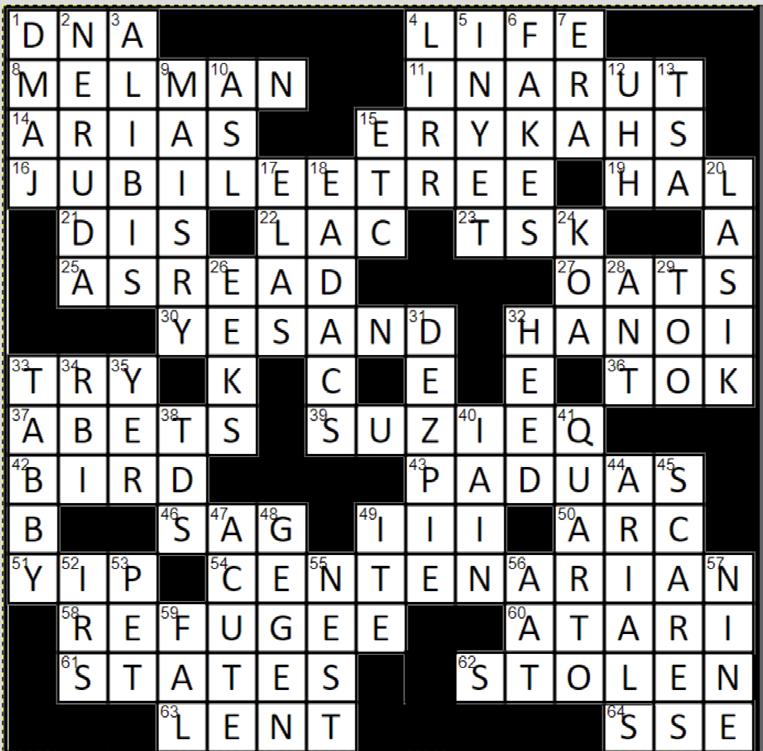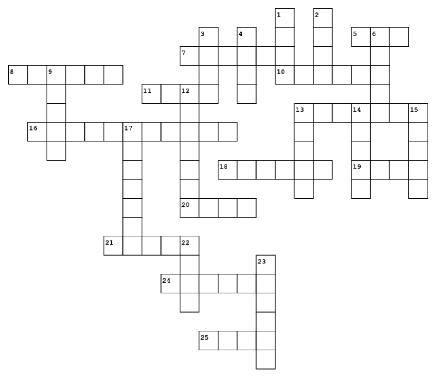Student crochets out of a case of conjunctivitis
Luke Jenkins Guest ReporterCollege, like any other period or place in time, is marked by a series of highs and lows. One such low for me (one could even say rock bottom) took place in the parking lot of Jo-Ann Fabrics. There I sat—in the hot vinyl seats of my friends’ Subaru Outback— both eyes red, swollen and crusted shut. Not from crying, but from conjunctivitis, more commonly known as pink eye, an infec tion normally relegated to eleven-year-olds with the hygiene habits of sewer rats. What does one do when they’re at their lowest low, sweating in the parking lot of Spackenkill’s favorite craft store? It’s an age-old saying: When you’re at rock bottom, there’s no way to go but up. And up I went. Well, out I went. I solemnly marched through the slow sliding doors and blaring fluorescent light to distract myself with an old interest of mine: crochet ing.
Interest, however, is a strong word. While I had indeed crocheted before, I had never managed to complete anything. You never would have seen me sporting my own cro cheted top, worried that one good gust of wind would expose my chest to the autumnal breeze. I never ripped off a pair of gloves that itched me to tears or showed off a scarf that neither warmed my neck nor allowed me to breathe. This winter, however, all that would be mine.
8
Campus community strives to increase access to contraceptives
Esther Cull-Kahn Guest ReporterFor the past year, Jenifer Lucia, the Physi cian Assistant and Clinical Facilitator of Gynecologic and Gender-Affirming Services at Vassar Health Services, has been conduct ing a new initiative that provides students access to long-acting reversible contraception (LARC), such as IUDs and implants. Before 2021, LARC was unavailable on campus, and students seeking related services were direct ed to off-campus gynecology offices. In a joint written correspondence, Director of Health Services Margot Schinella and Lucia stated, “Improving reproductive healthcare accessi bility for our students continues to be a fun damental goal for this department.”
Despite the initiative’s relative success, Lucia explained that she is still facing obsta cles making LARC as accessible as possible. Baldwin House does not carry an inventory of LARC, meaning that students must or der devices directly from the manufacturer. Although Lucia closely supports students through this process, individuals must still finance the device with their personal insur ance. If an insurance plan covers LARC as a “speciality pharmacy benefit,” students will not incur a cost. On the other hand, if the
plan covers LARC as a “medical benefit,” stu dents must pay for the services themselves, a notably expensive procedure. Lucia added, “In addition to insurance obstacles, there is often a delay in obtaining devices due to the need for prior authorizations and other vari ous forms of documentation that are required to complete the order.”
In a written correspondence, Co-President of Vassar Voices for Planned Parenthood (VVPP) Hannah Oppenheim ’23 recognized the barriers posed by insurance. She respond ed, “This should not be the case, and Baldwin is taking strides to mend the issues associated with providing sexual health resources for students with financial barriers.” For exam ple, Oppenheim explained, “Lucia is willing and available to work with students—regard less of insurance status—to discuss [the] birth control options available to them.” She also pointed out that unlike non-campus pro viders, Lucia does not charge students for the medication associated with LARC proce dures. Lucia and Schinella emphasized, “We are also actively communicating with com munity partners to streamline any off-cam pus referrals that are needed.”
Still, Louisa Gear ’25, Secretary for VVPP
Students across the Vassar campus react to the results of the 2022 election.
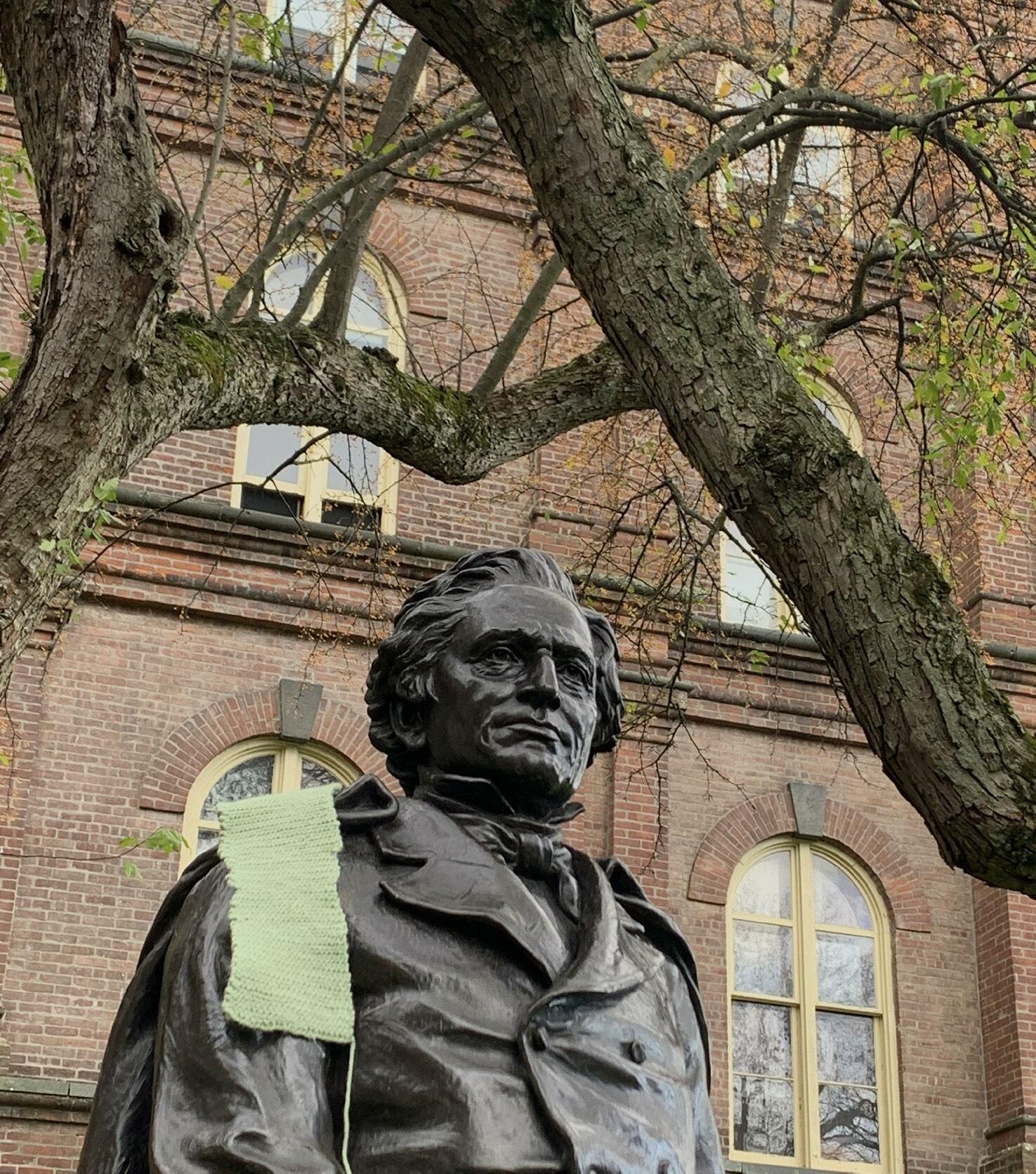
Vassar poll site
Jacques Abou-Rizk News EditorVassar earned a single polling location on-campus just 24 hours before Election Day to help increase youth voter turnout after weeks of litigation and uncertainty. The poll ing site will remain for all future elections, so long as Vassar maintains a minimum of 300 registered voters living on campus. Current ly, Vassar has roughly 1,100 voters currently registered, according to The Poughkeepsie Journal.
The League of Women Voters of the Mid-Hudson Region, with Professor of Po litical Science Taneisha Means and Magda lena Sharff ’26 as plaintiffs, filed a lawsuit against the Dutchess County Board of Elec tions (BOE), specifically Republican Election Commissioner Erik Haight and Democratic Election Commissioner Hannah Black for failing to abide by New York Election Law § 4-104, which mandated the selection of a designated poll site on all college campuses housing more than 300 registered voters.
The lawsuit came after the League received little to no response from the Dutchess Elec tion Commissioners, according to Jennifer Clark, Vice President of the League of Wom en Voters of the Mid-Hudson Region.
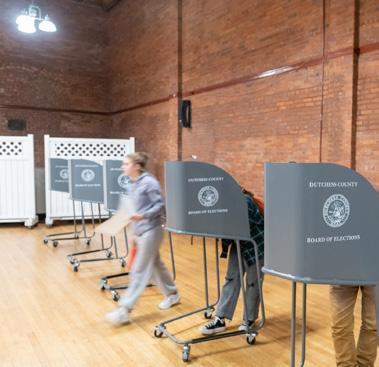
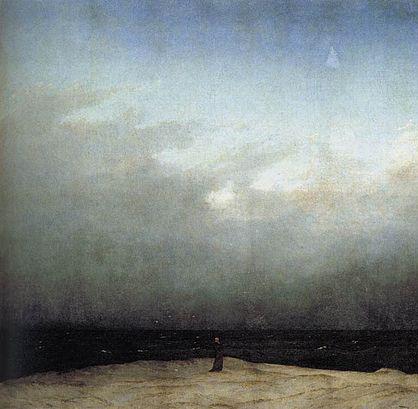
However, even before the League filed a lawsuit, there had been multiple attempts to reach the BOE, including a letter sent to the County by the Dutchess Student Voting
Art gallery explores memory
Naima Saini Columnist[CW: This article discusses racist violence, murder and the Holocaust.]
As a cognitive science major, I’ve spent a lot of time learning and thinking about the topic of memory. I’ve learned about its different types, the function memory serves for us and various theories about how our brains store the information we take in. But something else I’ve learned through studying the mind is that while science can take us far in understanding something like memory, we also can look elsewhere to deepen our understanding of it. One way to do that is through art, which is part of the reason why I was excited to see the “Memo ry and Oblivion” exhibit at the Vassar Art Li brary. Though it’s housed in a small display case, the exhibit is packed with stunning meditations on the title topic from a variety of different angles.
At the front is “Encyclopaedia,” a dilap idated encyclopedia. The pages are torn more and more closer and closer to the center, causing the words to be indecipher able. Sometimes jumbled together, some times broken apart, the book almost doesn’t look like a book anymore but rather some artifact. Wrapped around the bottom of the whole display case is “The Geometry of Memory,” an accordion-folded booklet
showing various images of a flower. Ac cording to the exhibition’s guide for visitors “This publication seeks to address the archi tecture of the brain and its ability to experi ence time as a function of memory through a series of folded loose leaves.” Though I couldn’t immediately see the connection between the piece and the neurological side of memory, I loved the idea of representing memory through something that can lit erally be collapsed and stored in a box, the piece’s simple beauty only further engaging me with the work.
The works in this exhibit vary significant ly in subject matter, though they’re all tied together by a common thread. Some, like the ones I’ve just described, offer reflections on memory itself. Others explore specific realities that are often forgotten or twisted, shedding light on how urgent the topic of memory is. For example, Mimi Tempestt’s poetry book “the monumental misremem berings” is about the oppression and death that Black women and femmes face in a racist, patriarchal society. In the exhibit, the book is open to a poem titled “melissa mckinnies,” named after a Black woman whose son Danye Jones was found dead in 2018. Though it was ruled a suicide, McKin nies has advocated for further investigation into the case because there is reason to be lieve Jones was actually lynched. The poem
See Memory on page 5The seniors of the Drama Department's production of "Pippin" had magic
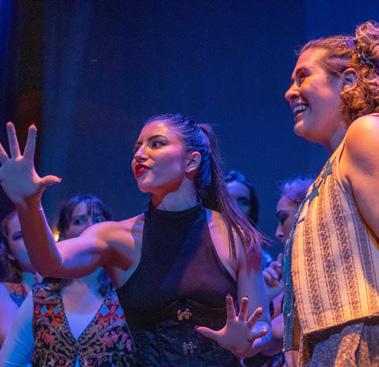
to do, and they sure did it.
As the weather cools and the sky dampens, Features Editor Kai Speirs reflects on the pres ence and essence of rain.
THE MISCELLANY NEWS
EDITOR-IN-CHIEF
MANAGING EDITOR
SENIOR EDITOR
CONTRIBUTING EDITORS
NEWS EDITORS
ARTS EDITOR
FEATURES EDITOR
OPINIONS EDITOR
HUMOR EDITOR
ASSISTANT HUMOR EDITOR
SPORTS EDITOR
SOCIAL MEDIA EDITOR
DESIGN EDITOR COPY EDITORS
GRAPHIC EDITOR GRAPHIC ARTISTS
VIDEO PRODUCTION MANAGER WEBMASTERS

BUSINESS MANAGER DESIGN STAFF
REPORTERS, COLUMNISTS
Leila Raines
Nina Ajemian
Monika Sweeney Janet Song
Annabelle Wang
Jacques Abou-Rizk Will Sorge Ganesh Pillai Kai Speirs
Sufana Noorwez
Madi Donat
Nicholas Tillinghast
Doug Cobb
Tracy Cen
Maryam Bacchus
Jacqueline Gill
Sashinka Poor
Karen Mogami Seowon Back
Tori Kim Ian Herz
Rohan Dutta
Chloe Gjoka
Phoebe DiLeo Ruby Funfrock
Emma Adams
Carly D’Antonio
Arlene Chen Katie Gebbia Allen Hale
Jesse Koblin
Anna Kozloski Gwen Ma
Jyotsna Naidu Sam Patz
Danielle Recco
Naima Saini Anna Terry Nick Villamil
COPY STAFF
Anica Acuna Caris Lee Emma San Flilippo Meera Shroff
CORRECTION
MISCELLANY NEWS | VASSAR COLLEGE Graphic courtesy of Sandro Luis Lorenzo ’24.Community wins fight to earn on-campus poll site
Coalition, in conjunction with Democracy Matters, League of Women Voters and the Andrew Goodman Foundation. According to Clark, “We wanted to bring this lawsuit, but we also wanted to have students involved. And faculty, because it directly impacts y'all as well. So we got Magdalena Sharff. She of fered to be a plaintiff as well as Professor Ta neisha Means. And so we started moving for ward, and we won the hearing.”
Vassar’s administration has also expressed interest in choosing an official designated polling location on campus for all registered voters. According to a written correspon dence with Wesley Dixon, Special Assistant to the President and Secretary of the Board of Trustees, the College expressed excitement for a designated polling location weeks ago, and even had recommended possible loca tions, as stated in the lawsuit. Dixon wrote, “The College began planning for the polling site as soon as the ruling was made last week, and we actually met with Board of Elections members (Commissioner Hannah Black and a representative for Eric Haight) in the Aula to go over the various needs, the afternoon of Friday, November 4.”
After winning the hearing, however, there came pushback from Haight and his attorney. In court on Thursday, less than a week until Election Day, Haight’s attorney objected on multiple grounds in an attempt to dismiss the lawsuit, according to Clark. “So ultimately, the Court denied his motion to dismiss,” she said. Friday, at 4:55 p.m., Clark said Haight filed a notice of appeal.
“Initially, we were very concerned that this meant there would be no poll site, because it was our understanding it would take more than a day to set it up. And the court wasn't going to hear anything before Monday,” Clark said. “So Monday rolls around, and the trial court says, 'My order was clear. This is an ad
ditional site. Nobody brought up closing other sites.’”
Clark added, “But just there was this loom ing behind [Haight] that they could face con tempt for not proceeding. And all of a sudden they said, 'Oh, we can do this in a day. Let's get it set up.' And so we have voting on campus.”
Treasurer of Democracy Matters Sara Law ler ’23 has been helping the student organiza tion work with various lawyers for the last few weeks. “It’s been a back and forth and we truly didn’t know that the poll site would be set up until the last minute,” Lawler commented.
According to Clark, New York’s new Elec tion Law comes as a result of similar litigation between Bard College and Commissioner Haight. As of 2020, Red Hook District’s poll ing site had been moved to Bard’s campus, but according to Bard’s website, Haight had desig nated a polling site that was not ADA compli ant before a second lawsuit had moved it.
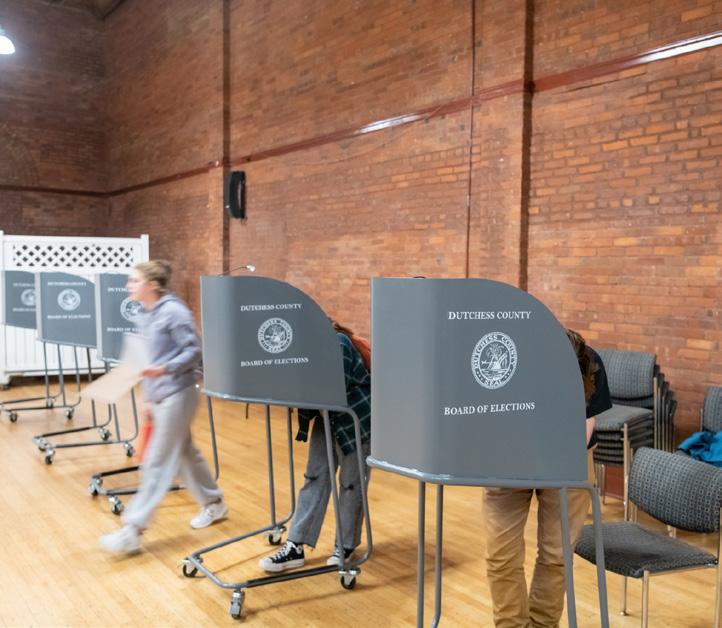
Clark said, “The idea is, I don't know if those same people would have voted if they had to go off campus. You can't squeeze that in between classes the same way you can just stop by right there as you walk from one building to another. I'm confident that it did increase turnout.”
The issue of college students having their voice and vote suppressed is nationwide, according to Clark. She said, “For example, Vassar College is split into three different districts. You have to go off-campus. And it's just basically a way to make it so the student voice doesn't count. There is no student voice because you're just split up and it's hard.” The recent New York Election Law will be imple mented in two stages. The first phase is des ignating a polling location. Clark said, “The second portion of the law is that when they redistrict next year, Vassar campus will have to all be in one district. So that way students will have a voting bloc, and it will amplify your voices.”
While official numbers are yet to be an nounced, Dixon estimated that 150-200 people voted in the Aula on Tuesday, Nov. 8, 2022. One student, Charlie From ’25, said in a written correspondence, “[V]oting in the Aula made the trip so much easier, considering I missed my first voting shuttle, I would have had to Uber to the previous polling location.”
From added that the last-minute change was a bit concerning, but they said, “I’d like to give the biggest thank you to our friends at Democracy Matters who made this polling site happen.”
Democracy Matters was in fact still work ing on informing students about the two pre vious polling sites up through Monday after noon. Lawler said, “We didn’t find out about the poll site until President Bradley sent the email to the entire school. Earlier that morn ing we had received word that there would not be a poll site on campus as there was not enough time to get the electronic voting ma chines up and running.”
She added that it went as well as one could have expected, given the tough circumstanc es. She said, “When we initially started work ing on this we thought it was pretty unlikely that we’d be able to make a change by this years’ election so I was really pleased that we were able to make it happen.”
In an effort to spread information on the new polling location on campus, President of the College Elizabeth Bradley sent an email Monday afternoon to inform students as to the new voting procedures for the next day. She wrote, “We were informed this afternoon that last week’s ruling by the Dutchess Coun ty Supreme Court designating a polling site on-campus will stand, and that by law the site must be available tomorrow. With last week’s ruling and the news this afternoon, we are currently underway with preparing the Aula (in Ely Hall) to welcome students and the lo cal community tomorrow on Election Day.”
Lawrence praised the administration for their help and support in bringing a polling site to Vassar’s campus. “Admin was very helpful in getting the poll site up and running. Given that it was [so] last minute, which was entirely out of their control, I’m not sure there was much more that could’ve been done to get the word out apart from PBs email,” she ex pressed.
Dixon added that in Bradley’s weekly Sun day email, she informed students of the un certainty given Friday’s appeal by Haight. He said, “Once we received final word Monday afternoon, she sent a campus-wide commu nication updating everyone with the details, which was amplified via Vassar’s website and social media channels.”
Local residents have expressed hesitancy towards adding a polling location at college campuses. However, Clark emphasized the importance of establishing these polling sites: “I understand some people—voters—feel col lege kids, ‘why are they voting here?’ But you guys are here almost all year round. You're counted in the census that gives us the num ber of representatives we get in the first place. You spend money here, you are affected by the laws that are passed here, of course, you should have a vote.”
Students react to 2022 midterm election results
Charlotte Robertson Guest ReporterTuesday, Nov. 8, was Election Day for the 2022 midterm elections. In what has been a remarkably close race, Vassar stu dents cautiously expressed hope concern ing the House and Senate results. As Max Brenneman ’25 said, “Going into it, I did not expect the Senate to remain in Democratic control and certainly did not think the race for the House would be so nail-bitingly close. As I’m speaking, we still don’t know who will have power.” Charlie From ’25, speaking on behalf of the Working Students Coalition (WSC), agreed: “We were all pleasantly surprised. We were expecting a Democratic wipeout which really didn't happen.”
Indeed, CNN reported that the anticipa tory “red wave” fell flat this election season, with Democrats winning critical races—Sen ator Catherine Cortez Masto in Nevada, John Fetterman in Pennsylvania and Senator Mark Kelly in Arizona, for example. Naomi Young ’24 emphasized that predictions for the past couple of elections have been inaccurate. In spite of this uncertainty, she is optimistic about the future: “The midterm elections have really eased any worry I had for Trump being a major candidate for the presidency.” She affirmed that Trump still has a major fol lowing, but that the midterms have demon strated a popular demand for someone new. “His endorsed candidates didn't do too well and it seems like Republicans are trying to find a new image after all of the havoc Trump has wrecked. That doesn't mean I'm totally blasé about the threat Trump poses or the Re
publican party as a whole, but it's a little less ‘do or die’ than it was in the 2020 election.”
According to a written correspondence with Michael Feltovic ’23, he said, “Most mainstream news outlets predicted a large Red Wave, so I was surprised, yet thankful, to see a clear Blue lead in the senate. I was also ecstatic to see Maxwell Alejandro Frost take the Florida 10th!”
Other students are more hesitant to cele brate. As Brenneman explained, “I am wor ried nonetheless…I was saddened to see Stacy Abrams did not win Georgia, and even more saddened—dismayed even—to see that Gover nor Ron DeSantis was re-elected in Florida. I guess there's an ember of hope…everyone seems to be confronting the fact that the way things are now isn’t working for everyone.” He added, “And I’m sad that Marjorie Tay lor Green was re-elected. If you haven’t seen her doing pull-ups, I highly recommend you watch it.”
From mentioned that the WSC encour aged its members to vote, but that the options on the ballot were not promising. “We're still pretty suspicious of the Democrats overall, any support we have of them is reluctant,” they wrote in a text correspondence. “We hope they achieve good things for working people.”
Vassar prepared a polling site at the Aula for students to cast their ballots, if they were registered in Dutchess County. Shuttles to the polls were also available. Voting was further encouraged by Vassar Votes, an ini tiative that offers resources and information for students to participate in elections, in cluding peer-to-peer support through volun
teering Dorm Voting Advisors. Jean Hinkley, Assistant Director of the Office of Commu nity-Engaged Learning and coordinator of Vassar Votes, described the initiative’s goals in an email correspondence: “Through out reach, we try to connect with students to in form them of upcoming elections and offer support in voting in person or absentee.” She expressed her own opinions about this elec tion, writing, “From what I've researched, it appears that voters had a strong preference for candidates whose views were not aligned with election deniers. I look forward to sup porting voters from Georgia as they prepare for the December 6th runoff election.”
Many students, like Madi Sandy ’25, voted by absentee ballot for their home state. She described the experience in a text: “Over Oc tober Break my mom and I went to our town hall to vote early. I was supposed to get my ballot in the mail, but it never came. Luck ily, I was at home so I could still vote, but I know others that could not do so because of issues with mailing.” Sandy echoed many of the aforementioned concerns about the “red wave” and said she was especially worried about abortion rights, one of the major is sues on the ballot this election season.
Feltovic highlighted the importance of this year’s midterm, which serves as an im portant turning point for the country. “This election was certainly critical for a number of issues, one of the most paramount being abortion; yet with prominent political play ers rising up on the Right, my concern is for the health and survivability of our democra cy.”
Many students like Feltovic are eager to
see what the midterms mean for the 2024 Presidential Election. “I really think it is too early to make real predictions for 2024, but the disappointment Republicans are seeing this midterm election seems to be shifting the trends of the Republican Party. Although Trump’s shadow still looms over the next election, other Red party members, especial ly Ron DeSantis, are catching the eyes of the masses.”
Jared Richie ’23 agrees with the senti ments about the upcoming 2024 election. “I was very surprised. I think the Democrats did considerably better than I thought they would considering Biden’s low approval rat ing and the normal midterm wave for the opposition party,” he said. “I’ve taken away that people are tired of Trump’s rhetoric and are more attracted to sane people. Trump has considerably less influence than I thought.”
Richie added, “Ron DeSantis was the clear winner of the night and it made me think that he has a much better chance in 2024. I think he could give Trump a real run for his money. I think it was also very good for Biden’s 2024 prospects which doesn’t make me too excited because I would have hoped for a more progressive Democratic candi date.”
If anything, the biggest takeaway of these midterm elections was that the United States remains divided. The Democratic win of the Senate and the projected Republican win of the House were marginal. It will be interest ing to watch the ramifications of such results moving forward.
Additional Reporting by Nina Ajemian and Jacques Abou-Rizk.
Sexual health resources on campus brought to light
and Campus Health Organization for In formation, Contraception and Education (CHOICE), asked, “What could be done if we were giving gynecological services and gen der-affirming care more funding?”
Along with Vassar Health Services, stu dent organizations like VVPP and CHOICE are working to widen access to sexual health resources. Felicity Rakochy ’23, the other Co-President of VVPP, specified the organiza tion’s goal in a written correspondence: “We are committed to accessible contraception, sexual health education, and reproductive rights at Vassar and in the surrounding com munity.” She detailed, “VVPP seeks to create a safe space for people to discuss sexual and re productive health and inform students about resources that are available to them, on and off campus.”
CHOICE and VVPP have similar objectives. President of CHOICE Ainsley Smith ’24 stated in a written correspondence, “Our main goal is to help keep the student body healthy and safe by making safer sex supplies easily acces sible!” Distinctly, CHOICE conducts a service in which students can anonymously order condoms, dental dams, lube and other rele vant supplies to their dorm for free. CHOICE also supplies Baldwin, the LGBTQ Center, student fellows and the Office of Health Pro motion and Education with the aforemen tioned resources.
Regardless of their work, “Access to gynae cology, STI testing, prescription contracep tives, and much more are all essential parts of sexual health that a student-run club obvi ously cannot provide,” Smith noted. Further, Gear questioned whether student organiza tions are doing the work that Vassar should
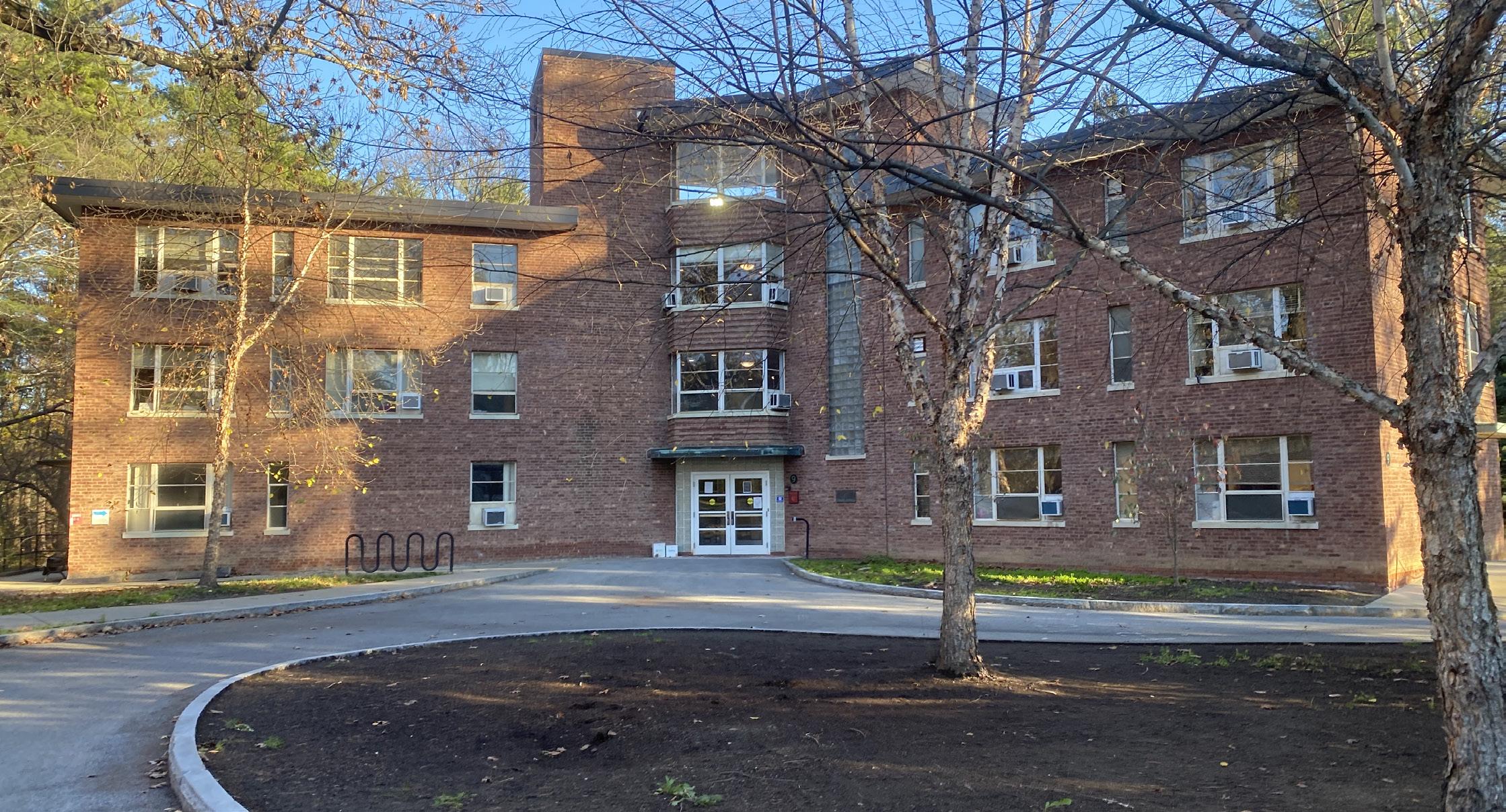
be responsible for, given the crucial role CHOICE plays in making non-LARC resourc es easily available.
While Gear recognizes the value in student groups identifying problems on campus and organizing effective responses themselves, she explained, “Student organizations are an
important part of Vassar’s inner workings to a certain degree, and then it’s the responsibility of the institution to be providing for us.”
She posited: “Is it a lack on the part of our institution that we are relying on the free la bor of students to have access to something that is vital for the health of the community?”
Exhibition explores significance of memory through art
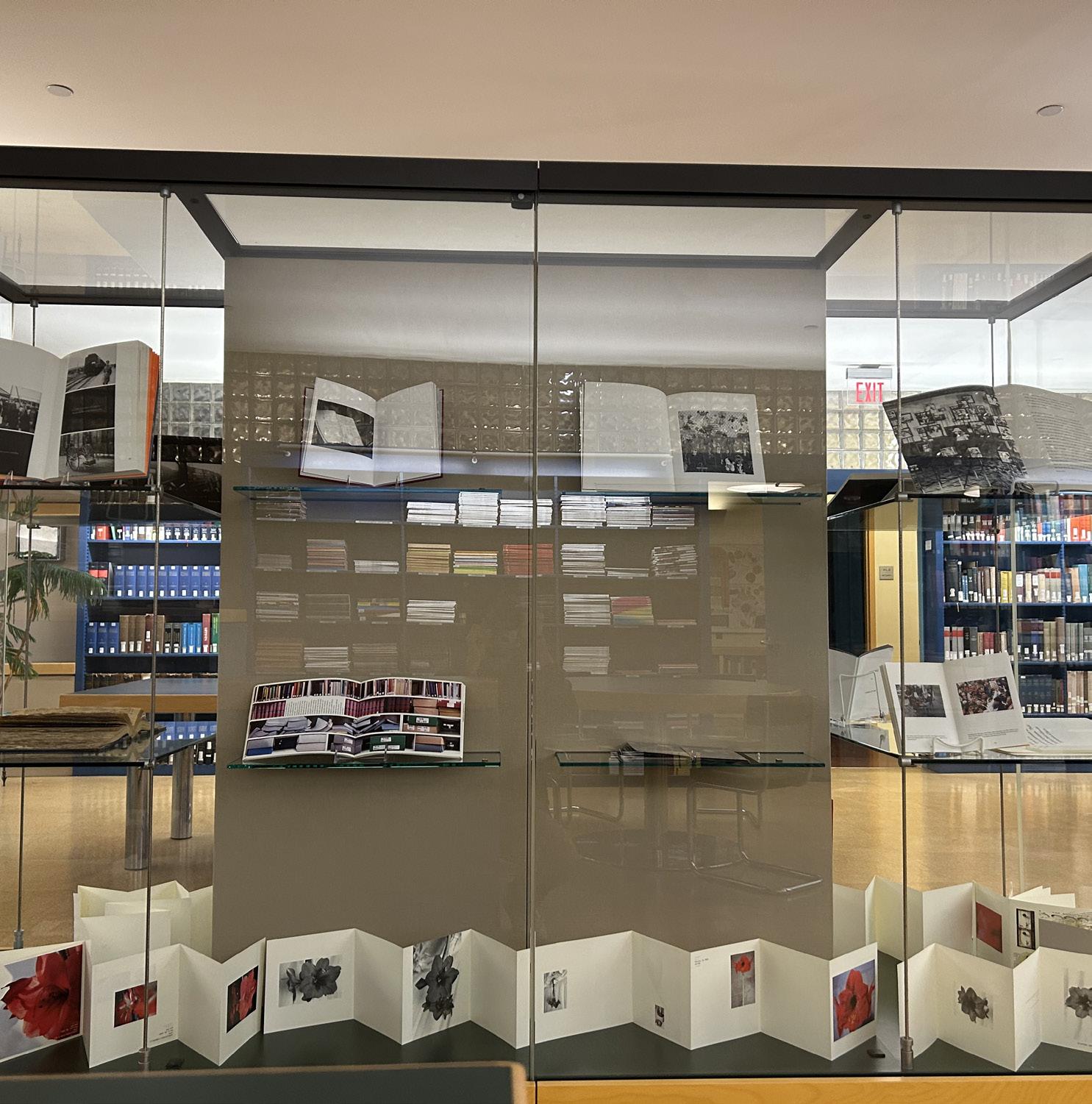
is in the form of a game of hangman, and through the medium of the well-known game Tempestt calls attention to society’s normalization of the murder of Black peo ple. And, as the title of the book suggests, the reader is asked to consider the historical and ongoing evidence of injustice that is misremembered because of the prevailing societal white supremacist narratives.
Many works specifically reflect on memory in the context of historical atroc ities. “Respite” by Harun Farocki displays chilling images of a train station during the Holocaust. Text interspersed with the photographs explains that the Nazis used the trains to send people to concentration camps. I was struck by the violence behind the images, even given their superficially non-violent content. A note in the booklet from the publisher of the book reads, “At a time when the last surviving Holocaust wit nesses will soon be gone, a possible route for commemoration is to ask what testimony images can give.” This question motivates the work, expressing the importance of finding alternative spaces for societal mem ory of the Holocaust when it can no longer be held by the people who experienced it.
“Himmelstrasse” by Brian Griffin also uses images to document the Holocaust,
this time using contemporary photographs. Griffin’s work depicts the train tracks like the ones in “Respite.” The photos are decep tively simple, showing just empty tracks in the midst of seemingly serene nature, but the knowledge of what they represent com pletely changes their meaning. By making the viewer aware of its horrific context, this work highlights how easy it is for historical memories to slip away into oblivion, even when it is of the utmost importance that we do not forget them. Of both exhibits, Art Librarian Thomas Hill writes, “These artists are motivated not to just accept the past as something over and done with, any more than healing is a mere blotting out of trauma, but to recontextualize the past in a lived, embodied present.”
The idea of memory as having a life in the present is something that can be applied to almost all the works here—by putting them all together, the exhibit grounds memory as a vital and salient topic in our fast-mov ing world. And as Hill writes in the guide, “the polarities of memory and forgetting in human experience take place in a mutual embrace.” The exhibit invites the viewer to consider how memory and oblivion co-con struct each other as time passes, and it does so in thought-provoking and powerful ways.
Drake and 21 Savage combine forces in latest project
Ganesh Pillai Arts EditorGalileo once famously proposed a thought experiment as such: If two objects are tied to one another, one heavier than the other, what speed would they fall? Would the lighter one “slow” the heavier one and cause a longer fall? Or would the heavier one “speed up” the lighter one, resulting in a quicker fall? In re ality, the objects would fall at the same speed, whether they were tied to one another or not. His point in conjuring such a scenario was to prove that some force other than weight was what determined the speed of such a fall, namely gravity. Does this principle of ob ject-independent determining factors hold for non-physical objects too? What about when two artists of different styles join forces to cre ate one project. Would the skills and tenden cies of one lessen or work to the detriment of the other? In theorizing about the case of “Her Loss,” the crooning, melodic Drake and the gritty, cold 21 Savage combine forces to deliver a project that is something genuinely additive and cohesive. Because just as with falling ob jects and weight, the quality of a collaboration of two artists isn’t about whether their styles are different or not. There’s another force at work: talent.
Drake and 21 Savage’s last two projects, “Honestly, Nevermind” and “Savage Mode 2” respectively, couldn’t be more different, both in sound and intention. The former sought to provide the soundtrack for a summer filled with memories, the nostalgic back bone of a season full of sentiments positive, negative and everything in between. The lat ter was a hard-hitting, grimy collaboration between Houston producer Metro Boomin and 21 Savage, whose trap beats and violent, explicit subject matter conjured up the deter mination and cold-hearted nature of winter, if anything. The individual abilities of these two rappers were not in question when they announced their surprise collaboration weeks ago—it was whether this experiment would prove our hypothesis of success, or go up in flames.
Our first evidence for this hypothesis actu ally came in the form of the concluding track
of “Honestly, Nevermind,” “Jimmy Cooks.” In hindsight, its inclusion was likely a har binger of the project to come. Drake and 21 Savage effortlessly work off of one another: Drake glides over the track’s initial soulful sound with unparalleled smoothness, while 21 Savage’s commanding, decisive presence contrastingly complements this sound in the song’s grittier second half. Picking up direct ly where this track left off is the intro to “Her Loss,” “Rich Flex.” Mirroring its predecessor, the track features 21 Savage instead rapping over a more melodic, R&B inspired beat as Drake concludes with a far more throughgritted-teeth bar delivery. For every action, there is an equal and opposite reaction, after all. While we knew 21 Savage was fully will ing and capable of rapping the typical lines associated with this delivery, hearing Drake spit with equal villainous vigor was a wel come surprise. Drake declares, “Get a lot of love from twelve, but I don’t reciprocate/ Fif ty-one division stay patrollin’ when it’s late/ 21 my addy so the knife is on the gate,” with the same blatant disregard and viciousness of his Atlantan compadre, proving within the album’s opening minutes that this Drake was a hungrier, meaner figure than the artist we had seen earlier this year.
This more aggressive attitude prevails among the album’s first few tracks. In the di abolical “Major Distribution” in which Drake details his sacrifices for success. On“On BS,”, as the title suggests, the pair enumerates what their opulent lifestyles consist of, whether it be trips to Ibiza, international business deals or spending exorbitant sums of money with out consequence (if Drake’s real betting re cord is any indication, we know he isn’t lying on this track). With this commanding start, the collaboration seemed to be going very well—this more hard-hitting Drake meshing incredibly well with 21 Savage. However, as is the case with any scientific inquiry, there are some variables that one has to assume to be true, qualities that characterize the objects in question. Drake, ever the melodic, smooth songwriter, is never shy to a slow, relaxed beat to unveil his softer, emotional side. If tracks like the album’s intro and its other, harder cuts feel like aggressive beats catalyzing Drake’s
more dastardly, arrogant persona, the more nostalgic, melancholic song of “Her Loss” works hand-in-hand with this other skill that Drake has mastered. On “Hours In Silence,” he expresses explicitly, “My confidence is low,” lamenting, “’Cause you know that you’re mine and it’s my fault/ It’s my fault, it’s my fault, for once I take accountability.” This spir it of self-reflection and honesty is undertaken by 21 Savage throughout the project as well as is an embracing of the occasional mellow reminiscence among the blatant braggadocio elsewhere on the album. On the penultimate track, he describes the toll that the killings of many close friends took on him and the way it greatly shifted his worldview, revealing the prevalence of debilitating race relations and systems of injustice within the U.S., and his place within it all. Particularly poignant, but powerful, is his assertion: “Passionate, I’m talkin’ with my hands, these ain’t gang signs.”
The album’s conclusion is a Drake solo effort, “I Guess It’s Fuck Me,” where the rap per reflects on the extremely difficult path to success that he followed, how it shaped him and the mistakes that he can’t seem to stop making. Concerning his regret at the end of a relationship, Drake does what he does per haps better than any other rapper: He makes music for experiences and feelings that any listener can empathize with and understand. Tellingly, the last words of his last verse on the album read: “Bet you’ve never seen a thug cry/ Hit me on my hotline/ And no ma, I’m not fine… at all.” If I had to choose one song to encapsulate why I have a deep appreciation for Drake’s music, it would be this one. His ability to speak to his audience, in jest, in sad ness, in triumph, in defeat, is unlike anyone in the genre. It doesn’t feel like we are listen ing to a music-making machine or a celebrity, but a person—a genuine fellow human. Every album, like a conversation between friends, spans a range of sentiments that only height en our connection.
So, what confounds this experiment? What factors work against its success? Most of the time, it’s those nagging constants that, while greatly outnumbered by their positive counterparts, do appear from time to time. Drake is no stranger to a questionable bar or
piece of song-writing that leaves a lot to be de sired. On the outro, Drake proclaims “I’m the first ever antisocial socialite,” which could be true improbably, but is surely not a novel idea by any means. On the otherwise very solid and Lil Yachty-enhanced “BackOutisdeBoyz,” Drake proclaims “I’m an owl but I’ll never tell you who,” to collective eye-rolling and groans from listeners, perhaps accompanied by a wry smile from his diehard fans, who knew such corniness was to be expected. 21 Sav age’s sexualized bars and explicit content also grows tedious after a point. While the album’s softer tracks gave the Atlantan the opportuni ty to showcase the heartfelt and thoughtful songwriting we know he is capable of, he of ten reverts to the subject matter his audience typically associates to him, the frequency of which works to the album’s detriment.
All of this is to say, in the question of how these two prolific, unstoppable forces of mod ern rap would react to one another, be it addi tive or reductive, the product is an unequivo cal success in my book. Drake maintains his melodic, soft side even while embracing the villainous persona of his partner in crime.
21 Savage remains the genuine, hard-hitting rapper unafraid to expound the details of a life many of us could never fully understand the difficulty of, all while allowing his more open, introspective songwriting to shine on various tracks. The pair’s latest project is an experiment in opulence, a meshing of extro verted exploits and self-reflection that proves the quality of artists such as these cannot be taken for granted–collaboration implies co hesion, and they have it down to a science.
Film and music combine to move viewers of 'Voices of Light'
Jackson Brogan Guest ColumnistLast weekend I was one of the many stu dents who, thanks to the generosity of the Vassar Ticket Fund, was able to attend “Voices of Light,” a joint production by the Hudson Valley Philharmonic (HVP) and the Vassar College Choir (VCC) at the Bardavon Opera House in Poughkeepsie, NY. The production’s title is a reference to an oratorio by Richard Einhorn composed to accompany Carl The odor Dreyer’s 1928 silent film “The Passion of Joan of Arc,” a historical retelling of the cap tivity, trial and execution of the young French saint that is widely considered a cinematic masterpiece. The experience of watching the film is so difficult to describe that I have to take a moment to separate it from the music to collect my thoughts.
Told mostly through a series of closeups, the film leaves no distance between the view er and the pockmarked, wrinkled, unpainted faces of the actors. There is not a single estab lishing shot with which to anchor yourself, less dialogue than I expected even for a silent film and every glimpse into Joan’s (or any) character comes with a reminder that the au dience knows nothing, that the characters are guided by something just beyond our view. It seems almost allergic to storytelling—Roger Ebert points out that the director infamously forced the lead actress, Renee Maria Falconet ti, to painfully kneel on the concrete set and drain all expression from her face, leaving only suppressed pain. Falconetti’s perfor mance is indescribably nuanced and beauti ful, and the role was so grueling that she nev er took a film role again.
Before the production began, VCC con ductor and director Christine Howlett spoke with the composer about the significance of the film and his compositional process. A welcome refresher on the story of Joan of Arc for someone who knows very little about ei
ther medieval history or film history, it also served as a foreshadowing of the meticulously detailed performance I was about to witness.
In order to accompany a film of such direct ed artistic vision, Einhorn had to plumb the same depths of historical accuracy. “The Pas sion of Joan of Arc” is assembled from actual court records from Joan’s trial, and the emo tion is grounded by the fact that what we see onscreen reflects the horrors experienced by a real 19-year-old girl. The libretto for “Voices of Light” is similarly constructed from ancient texts but tends towards the spiritual while the film stays strictly historical. Einhorn assem bles texts from a variety of medieval female mystics whose words scaffold our under standing of Joan’s spirituality, grounding her in a dismal political landscape while allowing the sublimity of her visions to shine through. More intimate texts written by Joan herself were sung by a quartet of VCC members in unison, and their performance became the focus of my attention and often kindled waves of emotion. The composer’s dedication to al lowing us to see through Joan’s eyes while the film tries its best to distance us from her is impressive; while writing the piece, he trav eled to Joan’s hometown in France to record the very church bells she claimed kindled the voices of angels. Those bells, when heard in the context of his composition, have much the same effect on the audience. The professional soloists elevated every text towards operatic elegance. The incredible performance of the HVP and VCC, anchored by Howlett’s metic ulous direction, let the boundaries between music and film, performance and recording blur into one overwhelming presence. The musicians performed with an earnest dedica tion that anchored the film rhythmically and harmonically, and their work shined miracu lously through.
During the pre-concert talk, Einhorn made clear his intentions not to make a soundtrack,
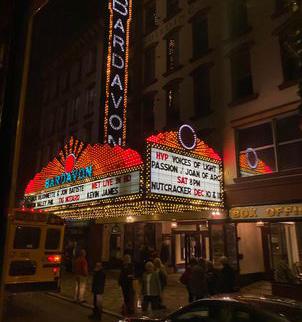
but to make music that is "real." What about playing music in front of a movie makes the music less real? The two arts compliment each other by virtue of existing together, oc cupying the same space at the same time. We trace meaning through simultaneity, al lowing the sound to converse back and forth with the visuals, neither overtaking the other. Although film and music exist outside each other, after seeing “Voices of Light” I cannot imagine experiencing either in isolation. The
choir standing imposingly in front of the screen, the orchestra placed delicately before them, was as impossible to ignore as the si lent flaming execution playing above them. And why should we attempt to separate the two? Why attempt to taxonomize and cate gorize what ultimately amounts to one great experience? And what an experience it was, leaving me with an overwhelming, intimate and deeply beautiful discomfort that I haven’t completely shaken since.
The Frightnrs' 'Nothing More To Say': unmodern modern classic
Music that investigates sounds and ideas rooted in specific cultural settings is, at times, overlooked in a media landscape that places a premium on the new and innovative. The Frightnrs, a local band from Queens, NY, released "Nothing More to Say" six years ago this September. At the time of the album’s release, it received wide acclaim, shaped mainly by the tragic and premature death of the group's moving force and lead singer, Dan Klein. Ever since, the group has been living in the shadow of tragedy, punctuating and tran scending its music to a reflection on mortal ity. The Frightnrs have released albums of remixes (“More To Say Versions” in 2017 and “Always” in 2022) after Klein’s untimely pass ing, but "Nothing More To Say" is an album that deserves to be revisited and considered a modern classic. The fresh approach of “Noth ing More to Say” is both respectful of its ori gins and technically inventive, conjuring the past while incorporating the present.
To appreciate The Frightnrs’ musical back ground, one needs to examine the band’s Ja maican music-inspired sound. The Frightnrs drew from and celebrated the sounds of rock steady, a musical genre borne at the crossroads of sonic germination and inspiration on the island nation. Fast-paced Ska was the zeitgeist in early ’60s Jamaica, but artists looked for a slower, gorgeous style suited for dancing. In spired by American soul and doo-wop, Jamai can artists such as Alton Ellis, Slim Smith
and Phyllis Dillon combined crooning vocals with a down-tempo variant of ska to produce the novel genre. Rocksteady’s domination over the Jamaican music airwaves lasted only a few years in the ’60s before morphing into more bass-and-keyboard-heavy reggae. The sound of rocksteady and the sense of easiness and nostalgia it evokes inspired American singers such as Johnny Nash with "Hold Me Tight" in 1968, and Blondie with their cover of The Paragons’"The Tide is High" in 1980. Because the architecture of rocksteady suits itself to slow dancing, it also recreates a di aspora of dancehalls that celebrate Jamaican culture, a distinct cultural setting displayed in Steve McQueen's excellent 2020 film “Lov ers Rock”, which you can still see on Amazon Prime Video.
The Frightnrs utilized the genre’s rich his tory when lead singer Klein met keyboard player Chuck Patel in 2011 at an NYC under ground reggae party. The two bonded over a love of the movement’s sound evoking vintage Jamaica, and they recruited drummer Rich Terrana and Patel's brother Preet to play bass. The group spent years honing its roots-influ enced style but was careful to avoid mere cul tural appropriation; The Frightnrs were com mitted to learning the rhythms and technical approach to rocksteady. Klein expressed that he wanted to respect his inspiration and not merely copy it, stating in an interview with NPR, "I sing in my regular voice; I sing as an American.”
Word about the group spread, and after a series of locally produced singles and EPs,
The Frightnrs signed a deal with Brooklyn's Daptone Records, a label notable for releasing music devoted to the sounds of vintage R&B, such as albums by Sharon Jones and the DapKings. In 2016, The Frightnrs entered the stu dio to record “Nothing More to Say,” their first full-length record, but the group knew some thing was not right with Klein—his vocals sounded strong, but he appeared physically weak. Shortly after, Klein was diagnosed with amyotrophic lateral sclerosis (ALS or "Lou Gehrig's” disease), the degenerative and fatal neuromuscular disease. The group finished the album, and Klein participated in interviews with the press, but tragically, he did not live to see the release of “Nothing More To Say.” Klein succumbed to ALS at age 33 in June 2016, just a few months before the album’s release.
Press at the time emphasized both the shock of Klein’s death and the strength and beauty of The Frightnrs' music, but Klein's death had unfortunately limited what un doubtedly would have been a remarkable career for the group. The music on “Noth ing More to Say” is proof—it channels the rich cultural and sonic history of vintage rocksteady rhythms but does not feel trite or derivative. Many crucial elements come together to create this terrific album; at the center are Klein's remarkable vocals, where he expertly employs a trademark of the genre—the falsetto. Klein's distinctive high voice is soulful and expressive, comparable to the best singing of the original rocksteady bands. The songwriting on “Nothing More
To Say” is uniformly strong (aside from two covers, all the songs are attributed to Klein or the group), and, in my opinion, there are no weak tracks (“skips”). Victor Axelrod’s album production is purist, capturing the texture of the danceable baselines and drummer Terra na's effective rhythms.
Listening to “Nothing More To Say” today is a profound experience: It evokes valleys of human emotion, melancholic ruminations, sorrowful memories and forlorn, dogged resistance. The comfort in the low-fidelity and steady beats feels entrancing, expanded to a spectral composition as Klein’s eternal ly desperate crooning breaks the heart. His lyrics adopt the position of the hopeless ro mantic, clinging onto lost relationships and uttering direct admissions of passion; his voice adopts an ethereality, half of this world and half removed. “Nothing More To Say” is a bittersweet reminder of the transience of life and the timelessness of art. The album immortalizes Klein, a ghost that haunts its record grooves and breathes spine-chilling dual meaning into every sorrowful word. Through listening to the music of the depart ed, we venerate their memories and honor their accomplishments in life and the beauty they left behind in death.
To explore key tracks by The Frightnrs and music that inspired them, such as songs by Sugar Minott, Myrna Hague, and Alton Ellis, I’ve put together a playlist that incorporates these tracks into a listening set. It’s amazing how The Frightnrs blend in seamlessly next to their idols!
ARTS
Drama Department production of 'Pippin' is truly magical
Two weekends ago, the second senior drama thesis took place. The student production of “Pippin,” a musical with a book by Bob Fosse and Roger O. Hirson and music and lyrics composed by Ste phen Schwartz, performed in The Martel Theater in the Vogelstein Center for Film and Drama. The show follows a traveling performance troupe as performers tell the audience the story of Pippin, the first born son of King Charlemagne and a new actor in their troupe who longs to find fulfillment. Throughout the show, the audience is invit ed to witness Pippin try all sorts of things to find the fulfillment he so desperately wants, all the while encountering acts of intrigue, humor, romance, war, illusion and sex.
“Pippin” brought in the efforts of esteemed actor James Caverly as a guest director, best known for portraying Theo Dimas on the Hulu show “Only Murders in The Building.” The show also featured senior thesis mem bers Becca Chin ’23, Cameron Long ’23, Al
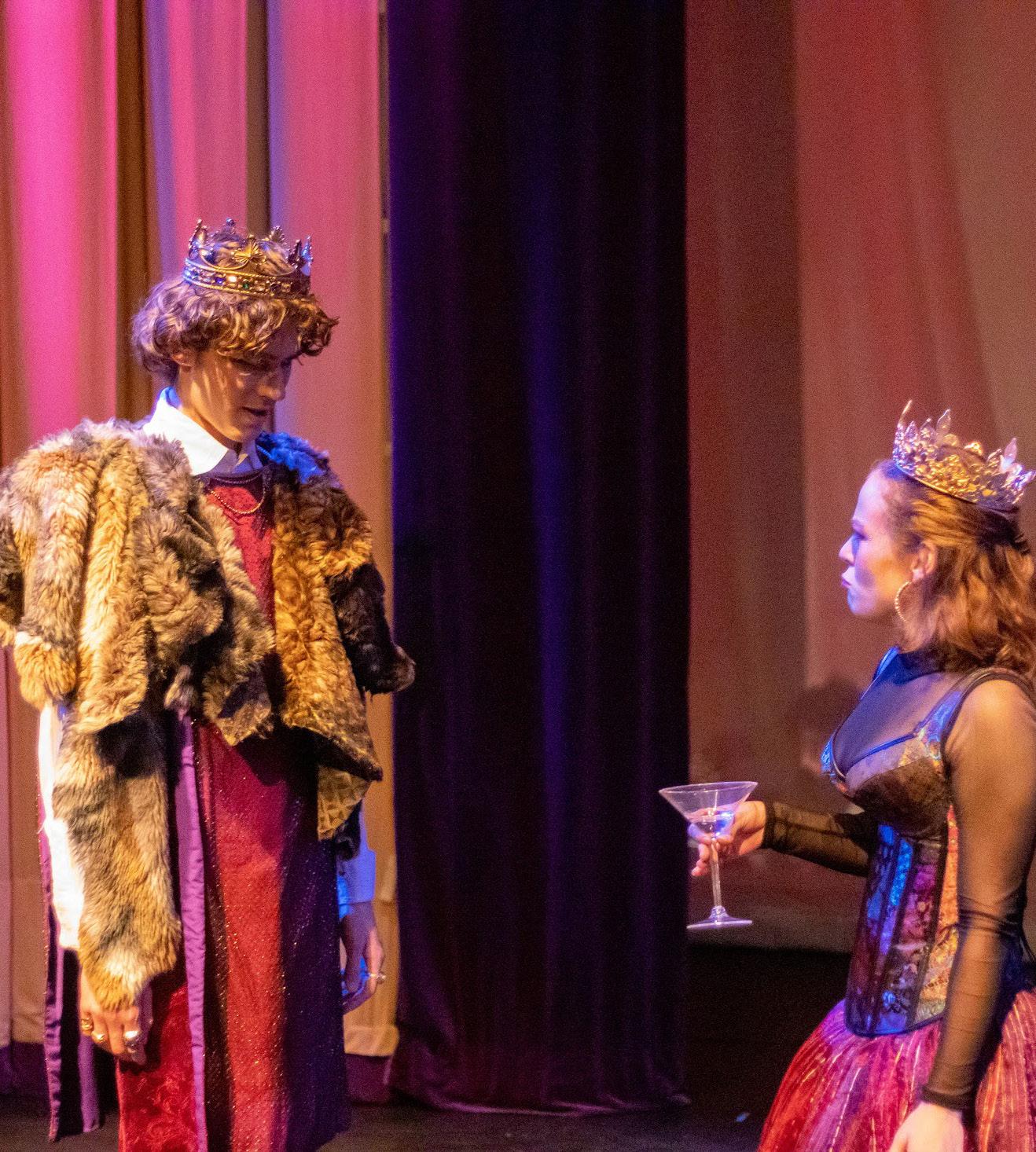
ice
’23,
’23
fea turing
all class years. The large ensemble complemented the story, allow ing the audience to follow the journey in a comprehensible way throughout the many twists and turns. Chin, Long and Downer gave performances as Pippin, The Leading Player and Fastrada and Pippin’s Stepmoth er, respectively.
In the leading role of Pippin, Chin carried the plot through each new scene, tying an invisible string throughout the musical and allowing the audience to follow along. They had a challenging role to take on, since Pip pin is typically portrayed by a tenor male. However, she had an incredible persistence, ensuring they would not fall into the shad ows of her male predecessors. Chin’s come dic timing in the song “War is a Science” was excellent, and the jester-like movements of the ensemble fit perfectly with the spirit of the song.
As The Leading Player, Long absolutely captivated the audience with her emotive motions and omniscient state of being. Long’s dance break in “Glory” implement ed the Fosse style of choreography, featur ing some of his signature sultry jazz moves with plenty of hip rolls and impressively sharp details, considering how technical this style of dance can be. Long’s vocals were also spectacular, and you could feel the intent behind each note, movement and action that she took as The Leading Player. Her facial expressions were over the top in a way that made the traveling-troupe aspect
on the stage.
The last senior thesis acting member, Downer as Fastrada, was one of the most entertaining actors of the show; her come dic timing was spot on, and she created a character that was equally lovable and dis likeable at the same time. In Fastrada’s solo, “Spread A Little Sunshine,” Downer had the whole audience in a trance and want ing more, engaging viewers through dance and seduction. In addition, it must be men tioned that Downer’s upper body strength and flexibility were absolutely insane, as she fully lifted herself off the platform she was on using a pole and lifted her leg up par allel to her torso.
The senior thesis members weren’t just actors though, as Zak led the orchestration eloquently as the Music Director and Jones ensured that every set piece and actor was where they needed to be as the Stage Man ager. Zak’s ability to conduct a pit of 14 mu sicians was astounding and being able to see her work her own magic behind the scrim was a feat. Zak also made an appearance on stage at one point, showcasing her truly im pressive accordion-playing abilities. As for Jones, there was a flow to the transitions of the show that would not have been possible without her work. Each scene change glided along and helped to further emphasize the storytelling.
A few other honorable mentions include Abbye Friedman ’25 who played Berthe, Pip pin’s grandmother, and Madelyn Ockner ’25 who portrayed Catherine, Pippin’s love in terest. Both performed spectacularly, with
Friedman really playing up the comedy and charisma and Ockner giving the audience the heartfelt ballad that is essential in every musical.
Even with all of these star qualities, there are a few elements of “Pippin” I must cri tique in order to give my honest review, spe cifically looking at the Drama Department’s role in the production, not the students. While the Drama Department hired an ex ternal guest director, they did not hire a cho reographer, leaving the senior thesis mem bers to choreograph the show themselves. With senior thesis members also learning their lines and songs, having to create cho reography for a dance-intensive production only added to their workload. Even if it wasn’t in the budget to get an outside cho reographer, and acknowledging that Vas sar’s Drama Department is an experimental theater program not a musical theater pro gram, I wonder why the department did not reach out to dance students or professors to help alleviate this responsibility off of the students. Furthermore, in talking to ma jors within the Drama Department I have found that there is an understanding that
the Drama Department does not have mi crophones, which seems odd for a program focused on the performing arts. For a school that charges $81,360 per student per year, according to the Vassar Financial Aid Ser vices website, with a handful of the money going to each department for educational purposes, why has the Drama Department not made the investment in microphones? As there have been a handful of musical theater productions in the Drama Depart ment, with two in the last year and I’m sure more to come in the future, purchasing mi crophones is an investment that would be beneficial to the department. The need for microphones is apparent when looking at “Pippin”—in some cases, there were issues with the sound when actors turned away from the audience and it became hard to hear over the orchestration, to no fault of their own.
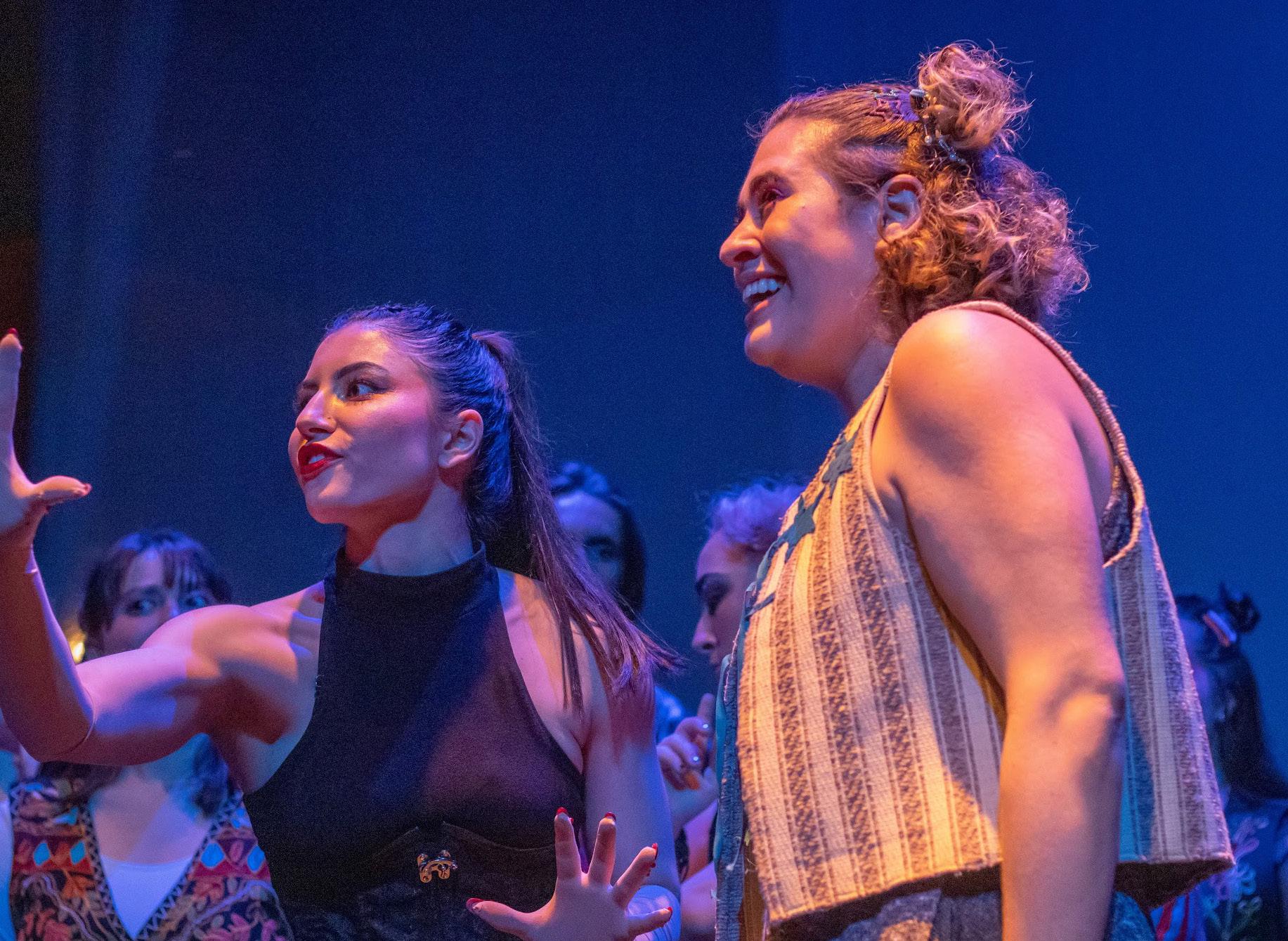
Despite these critiques of the Drama Department itself, the students who per formed in and worked on “Pippin” did an astounding job. Congratulations to the cast and crew of Pippin—their dedication to the production is admirable for sure.
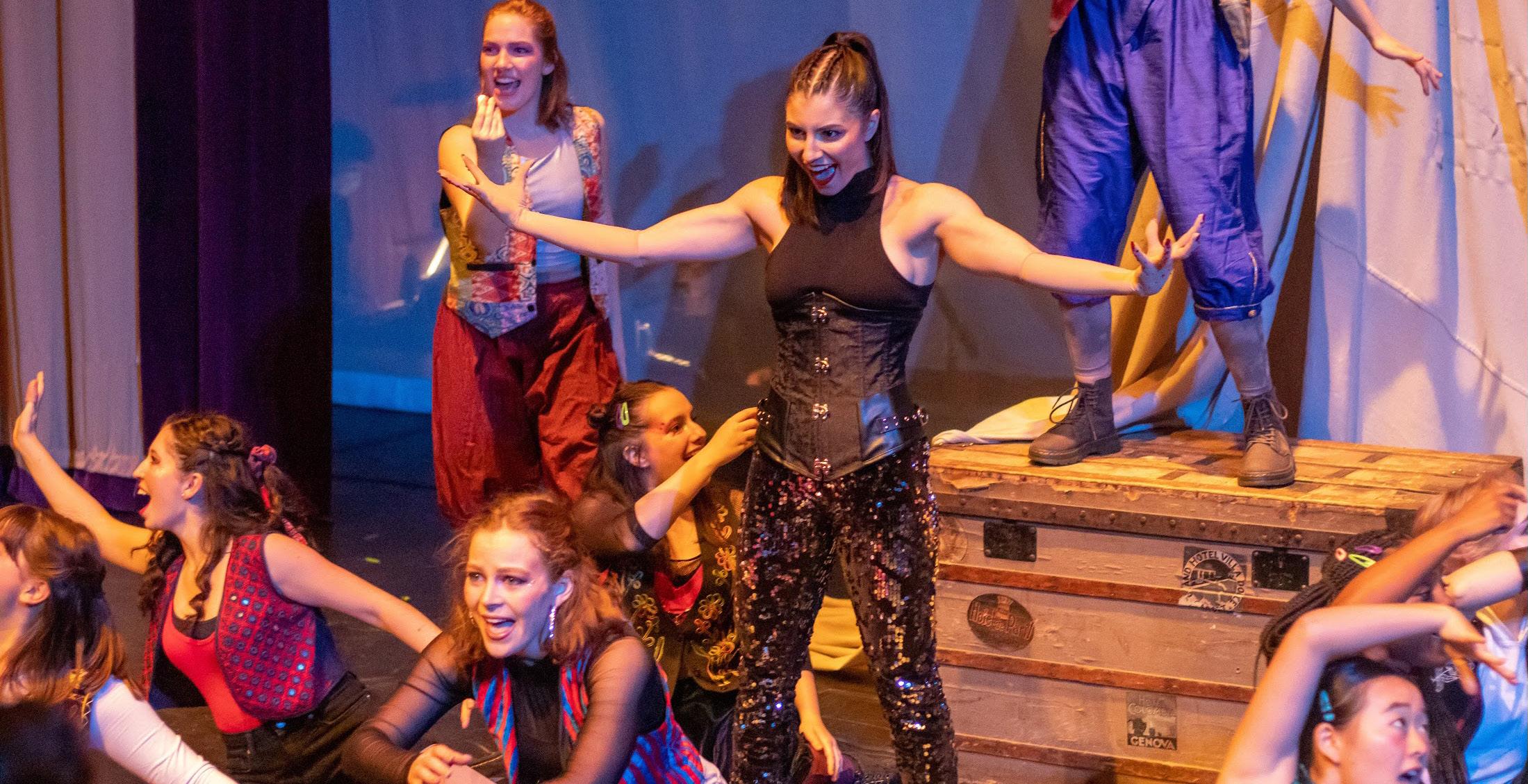
FEATURES
Student crotchets his way out of conjunctivitis
Continued from Crochet on page 1My yarn of choice was a thin lettuce-green, my crochet hook five millimeters in diam eter. I rushed to pick them from Jo-Ann’s aisles, touching as little as I possibly could, before hurrying back to my Raymond double. There I sat, YouTube open, toiling over tying a slip knot, crocheting my first line, and then my second, with the final goal of a long, thin scarf in mind. After an afternoon of work, between eye drops and pills, my pink eye was rapidly improving. My crocheting was
not. The number of stitches in each row was slowly receding, to the point where my scarf was more like a pennant than anything else. Not happy with this segway into flag-mak ing, and the tinge of redness still frolicking around my cornea, I deployed my final cop ing mechanism: sleep.
To my surprise, my eyes had cleared up when I woke up that morning. I slowly forgot about the emotional low I had hit. One thing still bothered me about that odd October af ternoon, though. The ugly green pennant
still sat on my desk, mocking me as I washed and changed my bedsheets, typed away at my computer and returned my eye drops to the drawer. Not surrendering, not waving the white flag, I restarted on my scarf. Crochet ing line after line, incredibly slowly. When I noticed my project was thinning, I added a few stitches, desperate not to create a trian gular shape. The result was definitely not an gular, but curved, crimped and hideous. My friend chimed in: Just like its hue, my scarf looked like lettuce.
This lettuce scarf, while not even complet ed, is a blaring reminder of why I should be grateful for my return to good health, and a testament to the resiliency one hopefully gains after being dropped off like a sack of potatoes at these gates. Every student should have their own metaphorical produce-in spired garment. An object, an experience, that serves as an example of their own har diness, their own out-grown stupidity, a nice reminder to be grateful for how lucky we are to be here, in good health, out of rock bottom.
Award-winning author Jeffrey Eugenides comes to Vassar

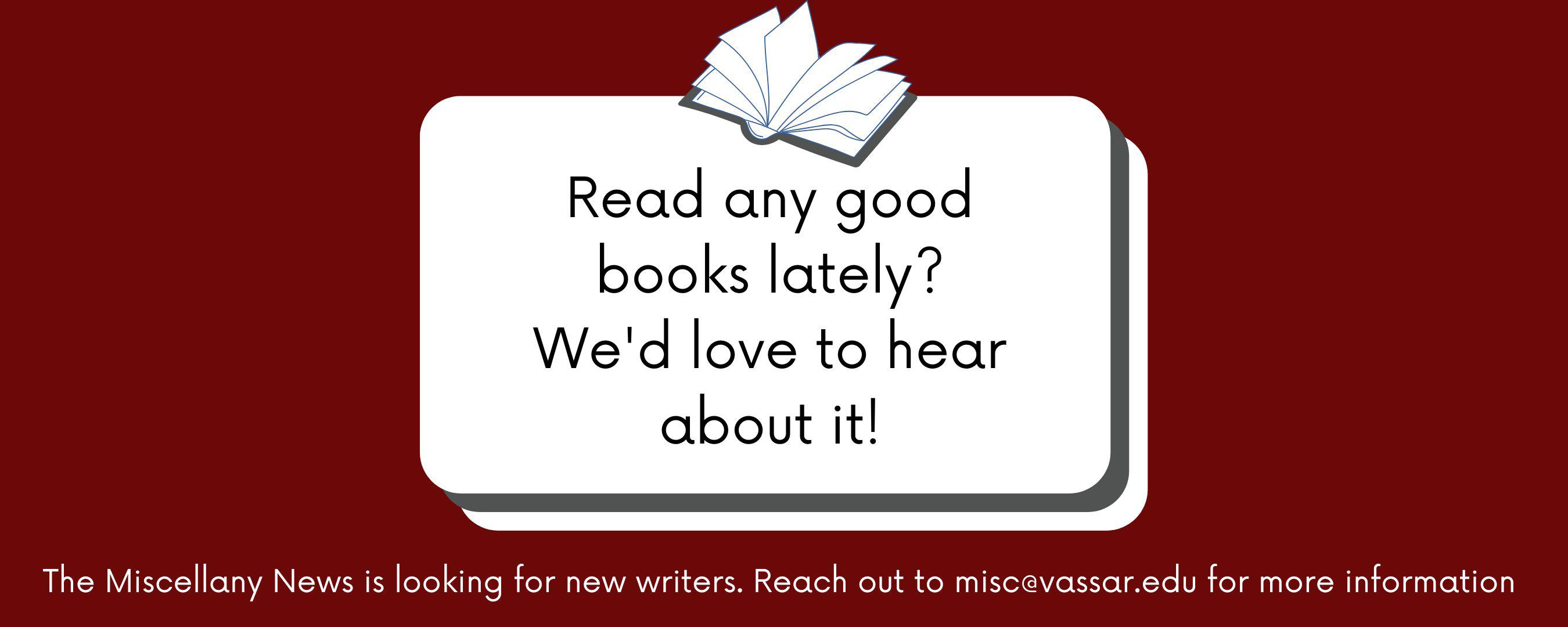 Emma Gross Guest Columnist
Emma Gross Guest Columnist
On Nov. 8 at 8 p.m. in the Villard Room, I listened to Jeffrey Eugenides, winner of the 2003 Pulitzer Prize for Fiction, read select ed pieces from his past work such as “Bronze” and an excerpt from “Middlesex” and speak eloquently on the process of writing. I had not previously read any of his novels, which only makes the fact that I found his words truly riveting all the more inspiring.
Invited on behalf of the Alex Krieger ’95 Memorial Lecture series, Eugenides walked into the room and the audience erupted into applause. He sat down in an armchair on the stage, across from Amitava Kumar, Professor of English on the Helen D. Lockwood Chair. This set up, lacking the traditional “stand-up in front of a microphone” concept, allowed for what I thought was an exceptional mood: equal parts comfort and intrigue. I felt as if I was invited into the living room of one of the most distinguished 21st century writers, and that I was also getting a glimpse into the most authentic parts of him.
With apt humor and a smile, Eugenides began the conversation by poking fun at the photo that was advertised to Vassar students regarding his visit. This was not the only time he displayed humor to the group; sever al times throughout the next 90 minutes he laughed at not remembering writing certain pieces he went on to read. He also indulged the audience in a story about naming a char acter after a woman he once had a crush on.
He then introduced listeners to two meta phors that I found extremely novel. The first involved a nuclear submarine, as Eugeneides claimed, “A novelist is like a nuclear sub marine.” Referring to the way a submarine innately functions, popping up and down every so often with long gaps of invisibility,
Eugenides illustrated the ways he feels being a novelist has affected his life. He expanded this metaphor by saying that when he pokes up too soon as a novelist, he often gets detect ed too early. I had never thought of the fragil ity inherent in being a novelist, and this met aphor seemed to interest my friends as much as me, as it was one of the first things we talked about afterwards. Next, he employed a simile to explain what his biggest advice to young writers would be: “Write as if you were writing a letter to your smartest friend.” As someone who has had the privilege of hear ing many authors and poets give advice, I was particularly in awe of how helpful and tangible this string of guidance felt. Writing a letter is intrinsic in expressing vulnerabili ties, while writing to a smart friend conveys a sense of thoughtfulness that must be present in writing.
With the evening coming to a close, one of the most important messages Eugenides brought with him was in response to a stu dent’s question. When asked how much he writes about his own life, he went on to say that he writes directly from the way he felt about things rather than what actually hap pened. Emotion is the crux of writing, and he spoke of how he often tries to translate real past emotions into the fictive elements of his characters’ lives.
As I exited Main that night, presumably alongside a room full of other prose lovers, I felt a sense of sincerity and awe that I hadn’t in a long time. It can be easy to view the writ ing process as something inherently tricky and ever-perplexing, but hearing Eugenides speak flooded the room with what I could only begin to describe as writer’s hope. I im mediately went back to Davi, carrying a copy of his 1993 novel “The Virgin Suicides,” and began writing.
FEATURES
Wandering through a downpour of rain-related art
Speirs Features EditorIt has been raining a lot as of late, a sign of the changing seasons as warmth leaves us until May (except for the odd warm day that seems to pounce on us all every once in a while). With the onset of chilly wind and the frequent rain of all shapes, sizes and fe rocities, I have found it nearly impossible to write about anything else but the rain and its general posey of associations. Rain is a subject both easy to write about and difficult to fully capture; its brush upon our lives is, at times light and at others, torrential. Rain has that sublime power similar to that which is gazed upon by a 19th century man gazing into the vast sea (“Monk by the Sea,” Casper David Friedrich), but it can also fade into the background of the scene, inviting itself into our moods and subconsciouses (“Blade Runner”).
out love,” it’s a relentless release of coldness, something to run from. But when Dylan, and the rest of us, run from the storm to find shelter, we often find warmth we weren’t expecting. The unnamed female character in the song calls to Dylan; she promises shelter from the storm that ravages the out side world. This becomes literally an under shelter/in the storm distinction, but it also mirrors the tumultuous feelings that may exist within Dylan and the storm of emo tions that explode outwards. Like any celeb rity subjected to endless press and criticism, Dylan was notoriously stormy to critics and the press. Only by retreating into the shelter of another person, perhaps a lover, is Dylan able to remove his protective raincoat and “open up.” “She walked up to me so grace fully/ And took my crown of thorns,” Dylan writes. While a storm is brewing outside, shelter, which we are lucky enough to be under, gains new importance and so do
that Mark Rothko is also native to Portland. She pointed me to Rothko’s “Blue Green and Brown,” a painting that seems to be drawn from rainy weather. The work mirrors a landscape painting, one where the land is dampened, made of pure form and utter ly immersed in the storm. The deep blue forms in the painting mirror misty clouds, and we become immersed in the swirl of mist and rain in a fashion akin to the most devoted Rothko fans who claim that upon viewing his works, they feel spiritual sen sations arise. While I can’t claim Rothko made the piece about rain, I can say that with rain on my mind I see the same storm in “Blue Green and Brown” as I do out my window.
Rainy days also make us strangers to those whom we may pass in full visibility on dry days; that is to say that in my experience, strangers we see at a distance become ever more estranged from us when we only see
“Flume” from “For Emma, Long Ago.” The somber tone, the deep dive into old mem ories and the lonesome nature of one man and his guitar point to obvious associations with rainy days, but more impressively, the song itself begins to sound like rainfall. Very few songs lean on ambiance as much as “Flume” does: quivering guitar strings, the continuing drumming (strumming) of three cords—it has an eerily interiorized sound.
Adjacent to the feeling of estrangement is the feeling of solemn calm which tends to drizzle into the psyche of people living un der the rain. It is as if the rain has numbed all that was twitchy, drummed so loud that it becomes hard to hear one’s own thoughts. Many people need rain sounds to fall asleep; it drowns out those thoughts that keep you up at night. This is because rain sounds produce something that lulls brain activity called pink noise, which honestly sounds pretty much like white noise (though there is some scientific categorization of differ ence).
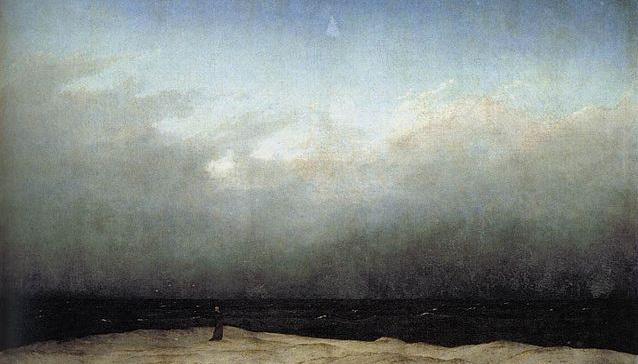
I realize my drizzle of thoughts has left out many iterations of rain. Missing is ru mination on the thunderclap release of en ergy that rain can also bring. You haven’t lived if you’ve never felt the allure of a rain adventure, the affirmation that what you are adventuring for is so worth it that you’d trek in the rain to get there. There is also the frightening power of rain, the catastrophic effects that both a lack of rain or an excess of it can have, especially for people living in places with underdeveloped infrastruc ture. With the rapid arrival of severe cli mate change, shifts in weather patterns will continue to haunt the human psyche in the near future.
There is at least one obvious explanation to why I leap to write about the rain: It com pletely dominates the scenes of our lives; on rainy days we either exist under it or we are hiding from it. From the basement of the Art Library I peer out the ground-level window and watch raindrops pool together; I gather my thoughts and write about the only thing that could possibly be worthy of writing about in that moment: the rain. Even when hiding from it I yearn for a feel ing of it; I draw phrases of W.S. Merwin’s “Rain Light;” I solemnly stride to the Deece with misty shoegaze in my AirPods; I crack open a friend's window to smoke and catch raindrops in my palm.
Perhaps this awe of the rain is instinctual; rain after all, is the bringer of life as much as the sun is. Humans, and all living things, really, need rain to survive—the fact that some of the earliest recorded deities in hu man history are rain deities demonstrates that the importance of rain is perhaps intui tive. Human nature, so to speak. But I’m no biological anthropologist, and I’m far more intrigued by the downpour of rain-related media since it feels far closer to my own life (I’m not growing food for my own survival).
Bob Dylan’s “Shelter from the Storm” is a great piece of rain media, an exemplary “rain song.” It plays on this escape from a muddied world, one where “nothing really matters much/ It's doom alone that counts.” Rain takes on the wet stains of the world, it’s “old men with broken teeth/ Stranded with
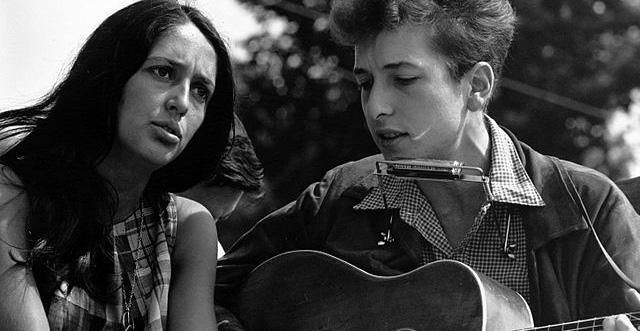
the people whom we share it with. There is something heartwarming about spending time with loved ones during a storm–we realize we are lucky to be where we are; not out there under endless skyfall.
Portlanders know the rain like a best friend, one that perhaps overstays its wel come but is loved nonetheless. I personally know many Portlanders who are in tune with the rain, one of which informed me
them under deep raincoats with their heads hanging low. On rainy days people tend to scurry from place to place; time may slow down for the person sitting by the window, unaware of the hour, but it gains a certain urgency to anyone out there in the down pour. We zoom by each other, our rain gear like tinted car windows. Bon Iver feels like a proper rain artist, one that strikes the chord of rain-induced loneliness, particularly
To attempt to come to any end of this storm (essay) would be difficult. Rain deep ly affects our psyche and echoes across countless pieces of media. At times, it acts as a mirror to our interior feelings, an ex pression of our feelings in the world. It also plays upon our own mental states, invoking feelings of loneliness, comfort, adventure and more. And rain can change character as rapidly as any person can: One moment we may find elusive mist hovering on in decision, and minutes later thunder could leap forth with an outburst of angry hail. It’s elusiveness; it’s sublime power and in timate reckoning; it's coming and going; the rain is an accompaniment to the entire range of human emotion. From the time storm clouds gather, to when the clouds fi nally part for the sun, all I can write about is the rain.
HUMOR
Breaking News
From the desk of Madi Donat, Humor EditorVibes have
Paul
McCartney,
Nicholas Tillinghast Amphibious MusicologistLast Saturday night, I had the opportunity to travel to New York City to see one of the most personally anticipated concerts of the year. I’ve been a fan of Kermit the Frog for a long time—he has easily been one of the most prolific frogs in American pop culture, but it's been nearly three years since we’ve heard from Kermit after he was audited by the IRS.
Frankly, it was a surprise to me that after not paying his fair share of taxes in 2019, Kermit would still be willing to play his ban jo in front of a live audience, but it seems Paul McCartney has that kind of sway on people. Kermit the Frog’s music has often been described as “smooth,” “reflective” and “anti-government spending.”
As someone who has heard of The Beatles, I had some background knowledge about Paul McCartney and his work going into this, and I was quite excited to see how he performed in front of a crowd. McCartney’s music has often been described as “sensa tional,” “spongy” and “patient.”
The doors opened at 2:30 p.m. to a rau
study reports
T-Pain, Kermit the Frog dazzle in NYC concert
cous crowd at the Quarter Horse Theatre in Manhattan, a low-lit space with many weak lights. Fifteen minutes after I sat down, T-Pain came out to much whooping from the mostly sold-out crowd.
T-Pain opened the afternoon with the 2005 club classic “I’m N Luv (Wit a Stripper)” and then immediately went into an anecdote about having to go to the DMV to get his car registered last year, a story that went on for 20 minutes and resolved with T-Pain regis tering his car. The crowd was not very into this portion of the concert. T-Pain then pro ceeded to close his set with “Buy U a Drank (Shawty Snappin’),” and then said, “I gotta get back to the DMV, thank you Blue York!” In writing this, I would have assumed he said “New York, '' but it really sounded like “Blue York,” and also he raised one eyebrow after saying it like he did it on purpose and it meant something. Regardless, it was a very good set from T-Pain.
It was around 3:30 p.m. when Kermit and his house band finally walked on stage. Ker mit the Frog opened his set by first praising long-time friend, T-Pain. “We first met in 2009 after the recession and have been great
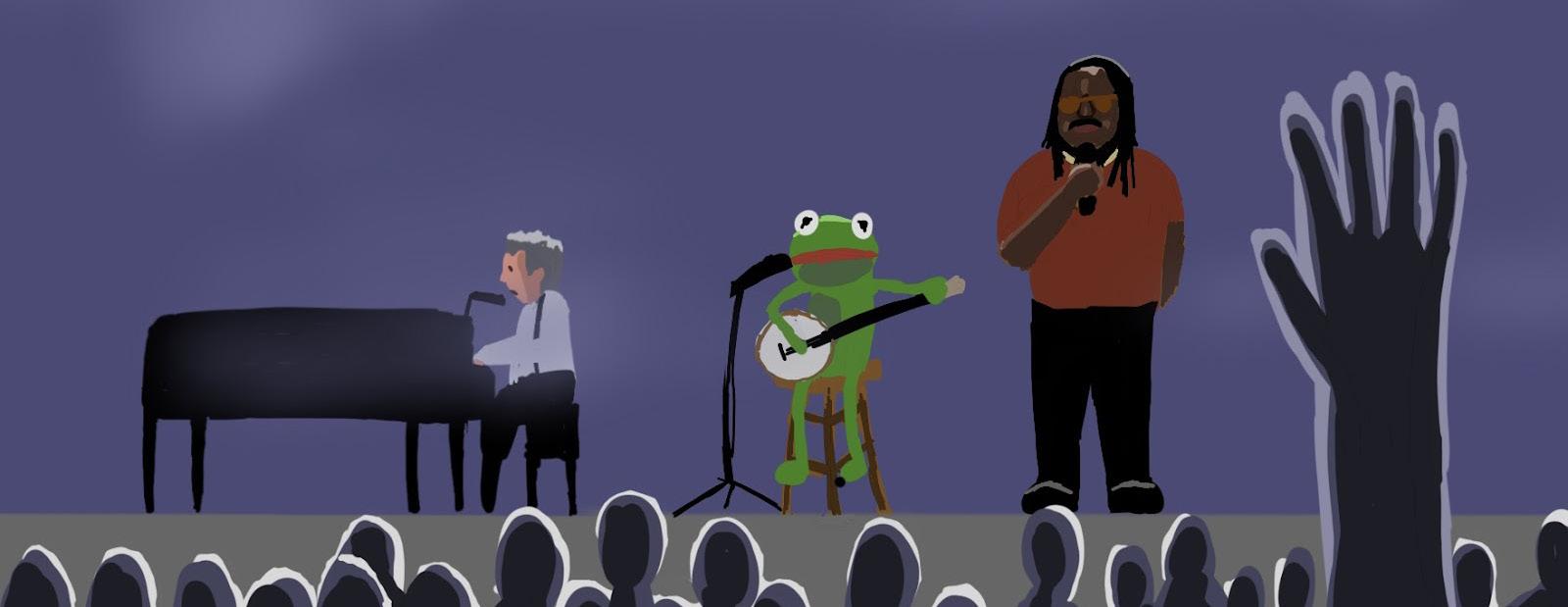
friends ever since. T-Pain has really been my rock through a lot this past year.” He opened with “Moving Right Along” and then went right into “Bein’ Green,” two of his most spongy tracks, and then Kermit said, “Ev erybody in the audience, please welcome 3-Pointer!”
Hip-hop music started playing and out came a dude in a red ninja mask holding a microphone. Kermit sat down at the edge of the stage and started smoking. I was unfa miliar with 3-Pointer and he wasn’t in any of the promotional art, so I unfortunately don’t know any of the names of the songs that he performed besides a pretty tight cover of “Hotline Bling.” The crowd was really into it, more into it than when Kermit came out. I would suggest that 3-Pointer looked vaguely like T-Pain in a red ninja mask, had T-Pain not already announced his DMV departure earlier in the show.
Kermit came back onto the stage and fin ished the set with “Rainbow Connection” as a duet with 3-Pointer. It started with him trying to figure out what key it was in, mov ing his green hand up and down the banjo. “That’s not it. That’s not it either. Wait, I
was right the first time,” he said in his frog gy voice. Kermit proceeded to leave the stage and then Paul came out.
McCartney started his set by thanking Kermit and T-Pain. He remarked, “We met after the 2009 recession, and have been the greatest of friends since. We just fell in love with performing together.” McCartney played what I later learned was “Ob-La-Di, Ob-La-Da,” and then he played it again, but this time with a 10 minute free jazz section in the middle.
After McCartney’s set, Kermit and T-Pain returned to the stage and they all ended the night by singing “We Are the World.”
After a standing ovation, Kermit ended the show by saying that all the proceeds from the night’s show were to go to the Kermit the Frog Foundation for Dyslexic Youth. This is something I would be excited about if Kermit was known for financial responsibility.
On the train ride back at five that after noon, I reflected on this really epic collabo ration of three musicians in their prime. Al though McCartney, Kermit and T-Pain only played nine songs in total (3-Pointer played 10), it was nonetheless an excellent concert.
An ode to the benefits of having
 Cousin Itt Can't Be Tamed
Cousin Itt Can't Be Tamed
As the Ivy League Whorehouse, Vassar College is an institution at the intersec tion of utmost intellectual pursuit and abso lute tomfoolery. The same could be said of haircuts. In light of the growing trend toward pixie cuts, head shaving and other complete ly legitimate choices with regard to follicular bodily autonomy, I wanted to pen an essay addressing the dearth of appreciation for long hair at Vassar. Specifically, as well, I hope to detail why I am, in fact, the most powerfully sexy person here.
Firstly, long hair like my own provides cov er from the small-campus phenomenon of running into one’s enemies. As for my second point, I’d like to raise that, instead of expos
ing one’s skin to the cancerous potential of sun damage, hair cover is a great alternative. Third, leg-shaving is so fucking annoying; why would anyone feel obligated to do that when you could just, you know, not, and ac complish warding off farm-walk ticks at the same time?
And finally, in light of our institution’s reputation, I wanted to point out that some thing as inscrutable as an unexpected and unseemly mark on a neck can retreat even further into the invisibility of the College Center desk of our hearts if one simply covers it up by pulling long, luxurious locks in front of one’s shoulders. Of course, my hair is kind of everywhere, so I don’t even need to move it, which means there is absolutely no risk of making out with me at all.
long, luscious locks
plummeted so far that students unable to be vibechecked without bursting into tears and/or flames,Nicholas Tillinghast/The Miscellany News. Nina Ajemian/The Miscellany News.
ARIES


March 21 | April 19

TAURUS April 20 | May 20
GEMINI May 21 | June 20
CANCER June 21 | July 22
LEO July 23 | August 22


HUMOR
HOROSCOPES
Madi Donat Astral ProjectorBeing good at things is SUCH a rush. It’s really nice to hear that you are slaying. But what happens when you don’t slay? Not that you should prepare yourself for failure, but just remember that around the corner from every slay could be a flop. It’s a scary world out there. Be vigilant.

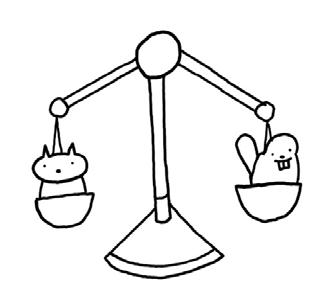
Sometimes, our minds go to dark plac es. Not, like, super dark, but dark enough that it’s weird. When you catch your brain being mean to you, as it so often does, pre tend that it’s a child named Jeremy who pretends to know how to ride a skateboard and wears silly shirts with puns on them. It won’t help, but it will be funny.

LIBRA September 23 | October 22
Revisiting 2010s classics has been a great hobby of mine recently. Remember “Glee”? I am very glad that “Glee” didn’t get to me until I was an adult with a mostly-formed frontal lobe, but I’m also upset that it got to me at all, because “Glee” is objectively a terrible show, and now it has its claws in me. Revisit classics this week, but do so carefully.
VIRGO August 23 | September 22
I’ve been having some shoe trouble re cently, and maybe you can relate. Maybe it’s just that my boots are not, in fact, made for walking because they are made of cheap plastic, and I bought them on Amazon. When things fall apart around or beneath you, remember that there is always another solution. Like getting better shoes.
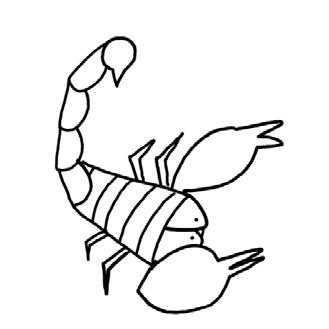
SCORPIO October 23 | November 21
What’s been on your mind recently? What’s been super annoying for you that you can’t stop thinking about? Try journ aling this week, to get those emotions out. Write to your journal like it’s someone you can’t wait to tell the hot goss. Maybe you will find a kinship, or fall in love. You could write a movie about it.
SAGITTARIUS November 22 | December 21
Sometimes, we (humans, students, bare ly-not-teenagers-anymore) can be embar rassing. Sometimes, we keep checking our phone even though we KNOW they haven’t texted us back. Sometimes, we put the book we need to read on our nightstand every night and then literally never read it. By we I mean you and you only, of course.

I have been biblically tired this week. Jesus has nothing on my 15-hour work weeks and the fact that this morning I dropped seven eggs on my kitchen floor. If you, too, feel biblically tired, try doing things all the cool kids did 2,000 years ago, like riding donkeys or burning offerings or doing carpentry or getting leprosy.
Sometimes I forget that I am the only person who lives in my brain, and then I say something and make the people around me a little wary. That’s okay though, because being playfully fright ening is a good way to get people to re member you. You can always be more playful about it, though. Try fun outfits.


CAPRICORN December 22 | January 19
Capricorns have a never-ending dili gence. While you were applying for in ternships or simply getting through the day, I was writhing around on the floor because I didn’t want to do a single writing assignment. But you’re allowed to shirk your assignments, too. Even if it makes you feel sad. Try writhing.
What are you reliant on this week? I am hesitant to call coffee a drug, even though it is, because of how dependent I am on it and how that dependence makes me feel. Maybe you’re dependent on other things, though, like external validation or a little sweet treat (both extremely valid). Just knowing what you need can sometimes be enough.
AQUARIUS
January 20 | February 18
PISCES
February 19 | March 20
Sometimes just hanging out with pals is the easiest way to boost your mood. You should throw a party with all your friends this week, and introduce all your friends who don’t know each other to each other so they can all bond over how much they like you, and you can feel good about yourself. An easy road to positive thinking.
Sickness is OUT! Getting really sad for no reason is IN! It’s really fun and cool to be in touch with your emotions, at least until your brain starts telling you things that only your most trusted therapist should have license to pull on you. It’s tough, but you can always just cry until your stomach hurts. Thank me later.
HUMOR
Alyssa Willeford Side Dish QueenThanksgiving is almost here, and you know what that means: It’s time to start planning your big day! The holiday is a cel ebration of American heritage, and what could possibly be more American than ar guing about politics with your racist uncle in front of an absolutely absurd amount of food? Of course, Turkey Day has its draw backs, too: the stress involved; the crazy cooking projects you’ll have to pull off; and the endless, endless dishes, to name a few. But never fear: As a senior, I’ve probably lived through more Thanksgivings than almost all of you, and I’m here to help!

First of all: Locate that turkey! The main problem with the turkey as the centerpiece of your table is that, to put it in technical cook ing terms, nobody likes it. Oh, sure, people are happy to chow down on a breast or a thigh every now and then, but have you ever heard anyone voice the same enthusiasm for tur key as, say, steak or bacon? But just because Americans don’t like something very much doesn’t mean we aren’t willing to fight over it. Despite the enormous glut of turkeys that floods the market every November, some body always ends up not being able to track one down. You don’t want this to be you, so simply purchase a frozen turkey well in ad vance, preferably during the Obama admin
istration. Better safe than sorry!

Secondly: Get cooking! Those of you who know me will know that I am a lifelong veg etarian, but never fear: I’ve seen all of three (3) Thanksgiving-themed episodes of “Good Eats,” and am fully prepared to dispense avi an advice to all and sundry. My main Turkey Tip is simple as can be. When it comes time to cook your bird, simply dress it, brine it, drain it, roast it and then take the meat and place it in an industrial wood chipper. The re sult will be flaky, with a good balance of light and dark pieces, and, as a bonus, no one will ask you to cook one of those goddamn birds EVER AGAIN.
Thirdly: Make your side dishes! After three paragraphs of blathering, we’ve final ly reached the section of the article where I could dispense advice pulled from anywhere other than straight out of where the sun don’t shine, but I will note that could is the opera tive word here. In any case, the best accom paniment to your big ol’ dead bird is a healthy helping of everyone’s favorite: cranberry sauce. Some people like to add orange, rum, spices and all kinds of other flavorings to their sauces; I then like to place said sauces direct ly in the garbage can when no one is looking. Thanksgiving is about eating food fit for chil dren, and I will not have my taste buds chal lenged on a day of the year otherwise entirely devoted to dealing with family.
But turkey and cranberry sauce alone do not a meal make. Technically, if you’ve been following my instructions to the letter, you’re probably further away from making a meal than you were when you started, but in any case, it’s time to move on to stuffing. This is also referred to as “dressing,” and you can choose to call it as such as long as you are comfortable with the knowledge that I am judging you harshly from over 6,500 miles away. Some people (probably the same people who make the toxic orange cranberry sauce) like to cook their stuffing inside the turkey, which is a solid strategy inasmuch as a sud den, violent case of food poisoning makes for a perfect excuse to clear out of Grand ma’s dining room. If you would prefer not to be hospitalized on a federal holiday, how
Anna Kozloski Mogami/The Miscellany News.ever, you should instead opt for cooking the stuffing separately, preferably for at least six hours at 500 degrees. After all, what’s a holi day without a merrily crackling fire?
So there you have it: a recipe for the perfect Thanksgiving. Of course, even following this foolproof plan, problems could still crop up along the way. In that case, don’t worry: Sim ply channel Ina Garten by laughing cheerily and opening up a big bottle of French wine. After all, if you don’t have to cook alcohol, you can’t possibly burn it! Right? Even you couldn’t manage that, right? Right? In any case, happy Turkey Day, and if you’ve been reading this safe and secure in the knowledge that you personally do not celebrate Thanks giving, don’t feel so superior. I’ll ruin your holidays next!
Thanksgiving: Surviving everyone’s favoritest holiday Poetry Corner
"Sad
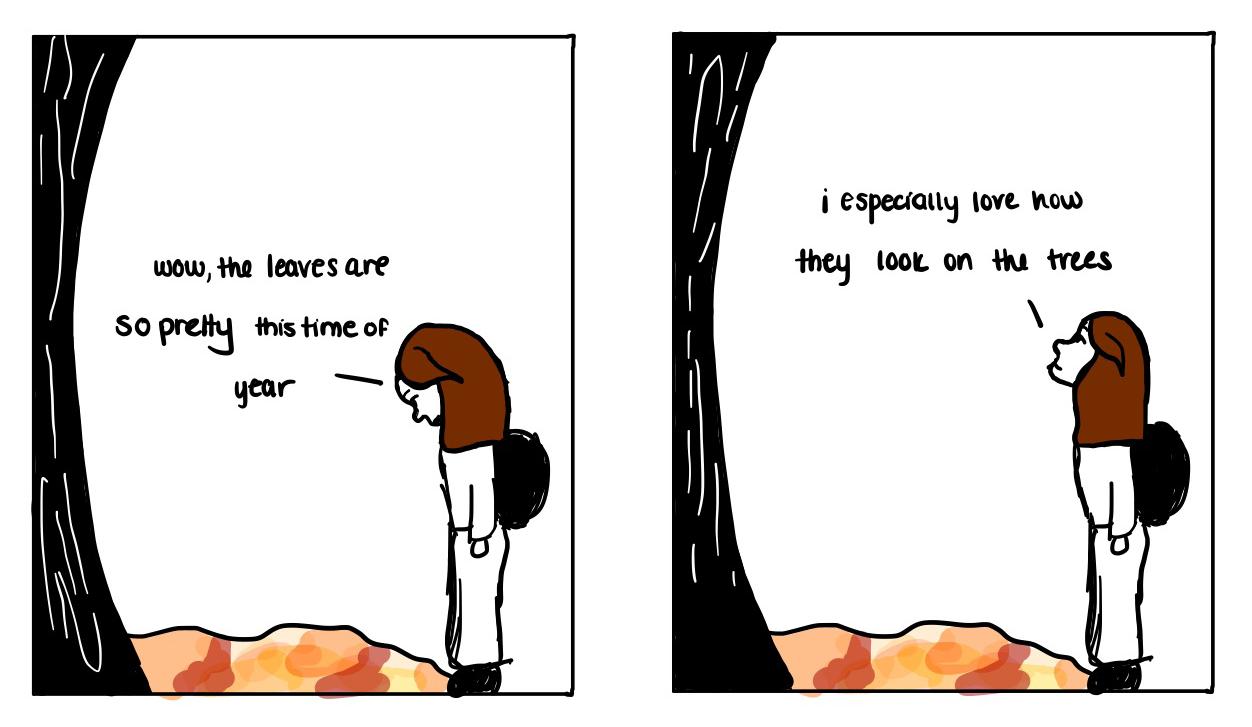
Girl
Autumn" By Leila Raines
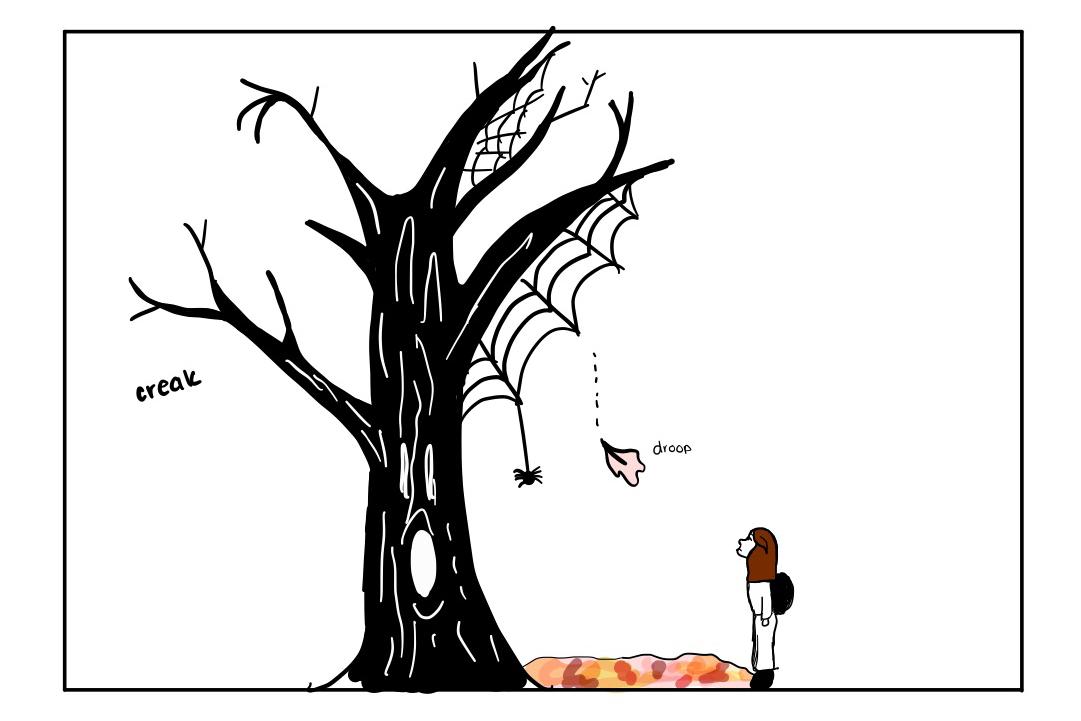
OPINIONS
Can we truly separate the art from the artist?
In our era of internet communication, scrutiny of celebrity behavior has in creased exponentially; one can hardly go two days without witnessing some new ce lebrity scandal splashed all over every major news source and social media platform. This proximity to the inner lives of celebrities and public figures has never been witnessed be fore, and it has produced interesting byprod ucts related to questions of what media we consume.
Upon finding out that one of our favor ite celebrities—whether they’re an author, singer or actor—has committed some act which is unfavorable to our current societal standards, it is a common reaction to won der whether it is still ethical to consume the media that they produce. There are several prominent examples of this, including J.K. Rowling, the once-beloved author of the “Harry Potter” series. According to Glamour, she has peddled transphobic rhetoric on her social media accounts for years, sympathiz ing with known transphobes as well as writ ing about her own thoughts on sex- and gen der-related issues on her own website. These comments have been widely identified as discriminatory and transphobic, and have led many of her former fans to not only de nounce her but to refuse to support her work any longer.
Similar movements have occurred regard ing many other artists as well, including the recent controversy surrounding Kanye
West, known professionally as Ye, who has recently doubled down on previous anti-Se mitic comments that he made on social media and in news interviews, according to CNN. Not only has West lost widespread fan support, but also a number of professional contracts with companies such as Adidas, according to The Guardian.
Whether this controversy surrounds one of your most beloved childhood authors or a musical artist whose songs you can’t get enough of, one thing is clear: Bigotry is intol erable and must not be supported in any way. This is much of the reason that when an art ist reveals their bigoted tendencies, the de fault reaction by many is to stop purchasing and supporting their work. This is the moral ly correct thing to do. We must strive to stop financially supporting celebrities who pro mote discriminatory rhetoric. Celebrities’ words have real-life consequences, and to be bigoted and perpetuate notions about histor ically marginalized communities, such as transgender people and Jewish people, fur ther legitimizes these opinions in the minds of people who may already subscribe to these beliefs. When people are emboldened by this legitimization, it can lead to actual, physical harm on marginalized communities. For ex ample, according to Fox News, the man who carried out a mass shooting in Buffalo, NY, this year cited Tucker Carlson in his mani festo, which embraced the dangerous “great replacement” conspiracy theory. According to Encyclopedia Brittanica, his theory sug gests that white people are quickly being re placed, culturally and demographically, by
non-white people. Carlson has widely been accused of pushing elements of this conspir acy theory on his television show, and this is just one example of the real-life consequenc es of public bigotry.
Therefore, it is effective to boycott and stop financially supporting artists whose values are misaligned with ours. In fact, it is our re sponsibility, as ethical consumers, to do so. It is, in many ways, impossible to remove the context of the author from the art that they create. Art does not exist in a vacuum—it is always a product of the social context under which it was produced, and even though bigotry may not visibly appear in the art produced by bigoted artists, its legacy will always bleed through. The art and the art ist are wholly inseparable, and it is our job as moral, ethical people to avoid supporting people who push bigoted rhetoric, even if it may rob us of the art that we hold near and dear to us.
While it can be effective to remove mon etary support in these situations, we must also ensure that works of art, especially those that have been societally consequen tial, are not fully censored. If such a thing can be done without harm to minority groups, even works of art that have origins in bigotry should be kept uncensored for the purpose of being examined and nothing else. For example, media like racist manifestos, as in the case of the Buffalo mass shooter, should undoubtedly be kept censored, as they are actively harmful and violent. How ever, pieces of media which are bigoted in more subtle, less physically violent methods
should be studied for their impact on society. This will ensure that future generations can learn how racism and harmful ideologies can be perpetuated and normalized in me dia, and how they ultimately affect society. Without knowing the mistakes of those who came before us, it is difficult not to repro duce them and recognize the warning signs ahead of time.
Such a thing may be difficult to reconcile, but is definitely possible. For example, many people probably still have copies of the “Har ry Potter” books and movies around their house, and they were probably an import ant part of growing up in the early 2000s. In fact, according to Forbes, “Harry Potter” is the number-one best-selling book series in history. Its impact on culture is undeniable. To deny it would be to refute the fact that a known transphobe can and did climb her way up to one of the highest cultural profiles in the world. She did so because we made it possible, and in order to ensure that society does not repeat this mistake, we must study how it was done in the first place; what ele ments of our culture and society allow big otry to prosper? An important part of this is studying their art, and while we must endeavor to remove all future monetary sup port to the artistic efforts of bigots after their bigotry is uncovered, we cannot un-spend the money or reverse the cultural impact of many of these artists. Instead, we must take care to denounce their beliefs at every lev el, remove all future monetary support and learn from the mistakes of the past so we are never doomed to repeat them again.
Inflection point for Democrats (Democrats should be worried)
Jacques Abou-Rizk News EditorAnother vital national Election Day has come and gone, and despite youth vot er turnout soaring in recent years, Dem ocrats have made very little progress on a number of promises, from reproductive rights to policies against gun violence. The slim margins by which many Democratic governors, Senators and House members retained their seats only serve as an exam ple of the disunity in the Party.
That’s not to say that Democrats should not be proud of the progress made in this year’s midterms. They will retain the Sen ate, and they managed to save many House seats from the supposed “red wave” that many Republican Party (GOP) officials promoted during the campaigning stage, according to The Wall Street Journal. But this proclamation of “Blue” or “Red” waves simply does not work. This became apparent to Republicans last Tuesday. Democrats, however, have also experi enced the spread of unrealistic election outcomes made by their party, particular ly in 2020, as reported by The New York Times. After four years of former President Donald Trump’s detrimental tenure in the Oval Office, it was expected that Demo crats would wipe the floor with the GOP. On the contrary, however, Republicans picked up 14 seats in the House. Despite the Democrat-held Congress the last two years, President Joe Biden struggled with vital legislation on inflation, gun control and reproductive rights.
As campaigning started last spring and the Supreme Court confirmed the over turning of Roe v. Wade in June, disre garding over 40-years of precedent, it was also expected that Democrats would gain
grounds in the midterm election on abor tion rights alone. While historically con servative states like Kansas voted to uphold some form of legal abortion in the state’s constitution, Democrats relied on the is sue to uphold the majority in at least one of the chambers of Congress, according to FiveThirtyEight. Democratic candidates relied on the vote of angry suburbanites to bolster their chances of taking large ly conservative areas, solely based on the premise of a radical turn in the Supreme Court. But this strategy didn’t work across the country. Radical conservatives like Governor Greg Abbott (Republican-Texas) and Representative Marjorie Taylor Greene (Republican-Georgia) still have better con trol over their regions than the Democratic Party does.
It’s clear with states like Georgia, where a runoff will determine the state’s Senator, and Pennsylvania, where John Fetterman won by only a slim margin, that Demo crats’ hold on their party is slowly slipping. Texas and Florida’s Republicans wiped the floor with their opponents. Democrats are not representative of the Party, but rather are at the whim of their state’s cir cumstances. Beto O’Rourke was caught in a frenzy with gun control throughout his campaign, switching sides from arguing, “Hell yes, we’re going to take your AR-15, your AK-47,” in a highly-reported Presi dential Democratic Primary debate back in 2020, to declaring he had no interest in taking anything from anyone during his gubernatorial campaign this year, accord ing to The Hill.
O’Rourke was called out for his contra dictory remarks during the gubernatorial debate back in late September. Even before election night came, O’Rourke stood very little chance with the instability of his posi
tions on vital issues. He was stuck between his state’s interests and the interests of the Democratic Party.
A study first reported by Politico in mid-October indicates wide support for gun control—66 percent of Americans. Among the policies supported are Red Flag laws, universal background checks, re quired permits and violent misdemeanor laws. Under Red Flag laws, according to The Washington Post, “[Y]ou don’t have to have a criminal record or a history of mental illness to lose your gun temporar ily. If a judge is persuaded by an argument that you are a danger to yourself or others, police can take your guns away for days, weeks, months or a year.” It serves as pro active legislation against violence, rather than reactive.
But for the last two years under Biden’s presidency, Democrats have failed to pass much legislation supporting these policies. The first “major” piece of gun legislation, signed by Biden last year, is the first of its kind in 30 years. But Democrats received only a fraction of what they had hoped for with the bill, according to NPR. In particu lar, Senator Joe Manchin (Democrat-West Virginia), infamous for his moderate opin ions, forced Democrats to surrender much broader legislation meant to tackle gun safety around the country, The Hill report ed.
Codifying abortion rights has been no different. Besides minimal legislation sup porting Planned Parenthood and obstetri cians, the promise of the codification of Roe v. Wade now seems impossible. Demo crats have failed to fulfill their promises to their party members, and while the mid term elections this year showed promise for a broken party, the GOP is close behind. Republicans are rallying a party to take on
the 2024 Presidential Election, and Biden, who is currently the only Democrat to an nounce their bid, has a faltering approval rate after multiple failures trying to pass concrete legislation, according to The New York Times.
Support for Biden and the Democratic Party is faltering and people are unsure if Democrats are ready and able to pass via ble legislation. Without solid stances on vital issues that grip the American public, Democrats will continue to falter behind a growing radical Right. After a solid stance, promises of legislation must be fulfilled. It is clear that the American people support such policies, and it is time for the Demo cratic Party to respond.
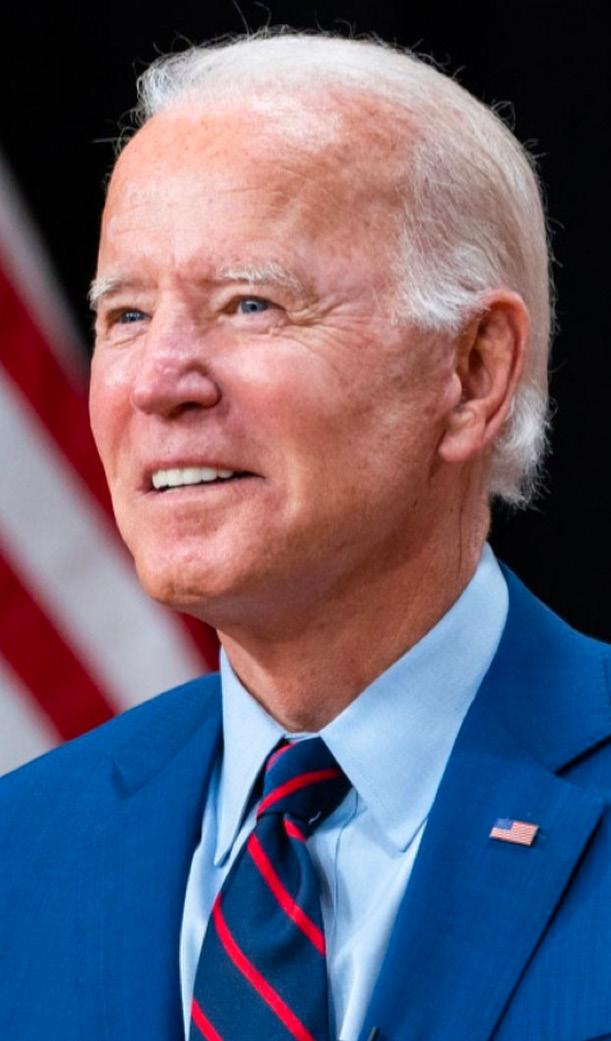
Vassar College Brewers Sports Roundup: Nov. 17, 2022
Cobb Sports EditorMen’s Cross Country
NCAA Mideast Regional Championships
Nov. 12
This past weekend the men’s cross country team traveled up north to Canton, NY, for the NCAA Mideast Regional Championships. The team had a strong finish to the season, placing seventh out of 23 schools with a team score of 169. The Brewers saw two runners finish in the top 35 to earn All-Region honors. Miles Takiguchi ’24 finished sixth overall with a time of 25:39.1 and Aidan Mayer ’24 placed 23rd overall with a time of 26:23.2. Both Takiguchi and Mayer earned individual NCAA National Championship qualifications for their performances. Next across the line for the Brewers were Andrew Blackburn ’24 and Davis Anderson ’26, who finished back-to-back at 44th and 45th overall with times of 27:14 and 27:18 respectively. Rounding out the scoring five was Jose Magana ’25, who finished 51st with a time of 27:39.6. Simon LaClair ’24 finished 64th overall with a time of 28:07.0, and Jason Cirrito was not far behind in 71st with a time of 28:13.8. The seventh place team finish is tied for the second best finish at the rRegional meet in pro gram history. The Mideast region was deep this year, with its top four teams all earning a bid to the NCAA National Championships later this week.
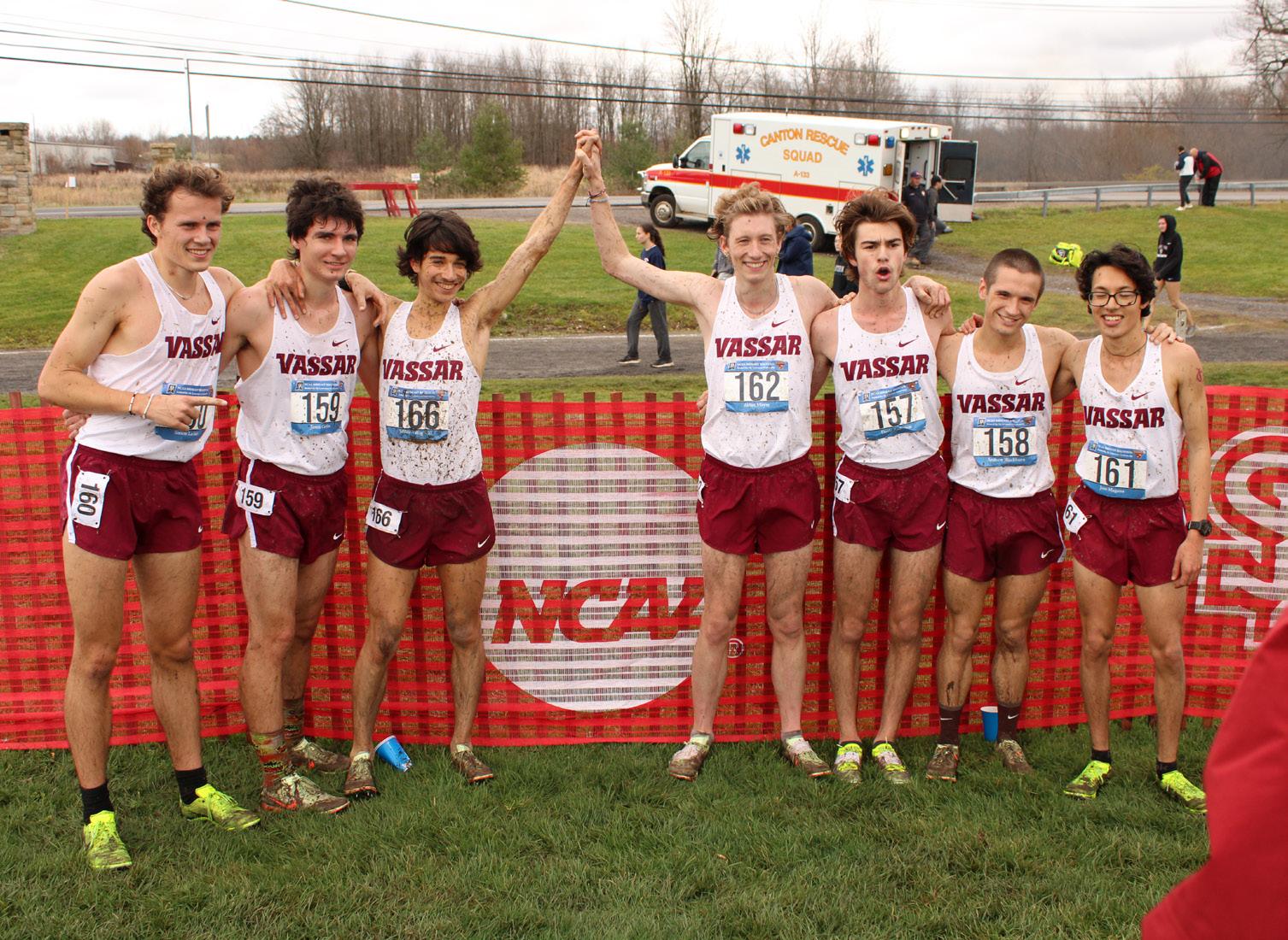
Women’s
NCAA Mideast Regional Championships
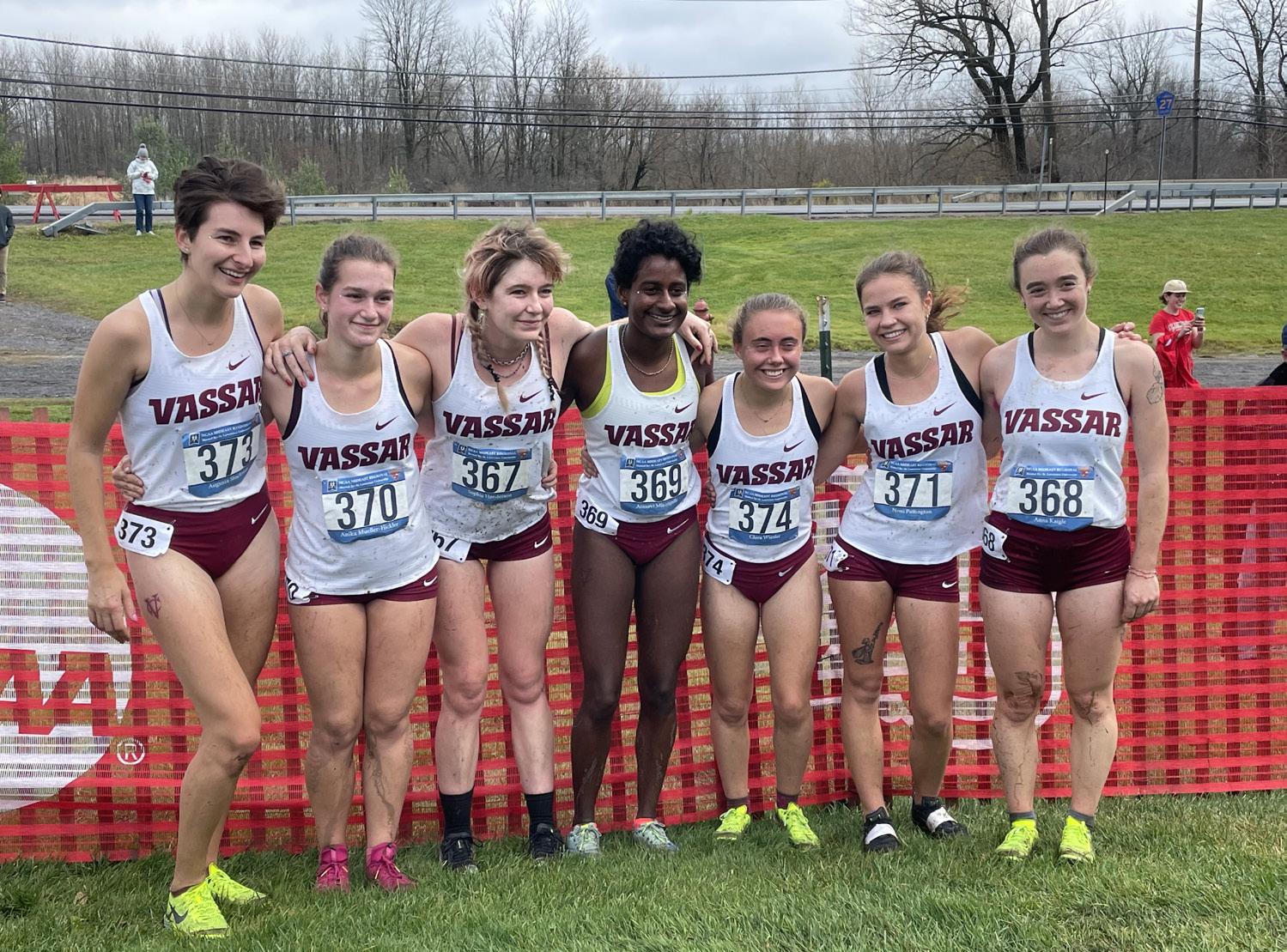
The women’s cross country team trekked up to St. Lawrence University in Canton, NY, for the NCAA Mideast Regional Championships this past weekend. The Brewers placed sixth overall out of 21 teams with a score of 184, just one spot shy of the five teams who qualified for the NCAA National Championships. It was the second best finish at the regional meet in program history. The Brewers were led by Augusta Stockman ’23, who finished 12th overall with a time of 23:01.2, earned All-Region honors for finishing in the top 35 and earned an individual qualification for the NCAA National Championships. The next Brewer up was Clara Wiesler ’23, who finished 37th, just outside of All-Region honors, with a time of 24:09.1. Not far behind her was Noni Pattington ’25, who finished 42nd with a time of 24:18.5. Right behind her was Anika Mueller-Hickler ’26 who finished 44th overall with a time of 24:19.4 to cap off her impressive rookie campaign. Vassar’s final scorer was Anna Kaigle ’25, who finished 49th with a time of 24:25.6. Rounding out the top seven were Sophia Henderson ’25 and Amaavi Miriyagalla ’24 who finished 58th and 105th with times of 24:45.6 and 26:52.3 respectively. The Brewers were propelled to their strong team score not only by their star senior Stockman, but also by the formidable pack of their 2-5 runners, all four of whom finished within just 16 seconds of each other.
NCAA National Championships
A day earlier, in the opening
of
narrowly edged out 13th-ranked Babson College in penalty kicks. The opening round match saw a score less first half followed by a Babson goal early in the second half. With their season on the line, the Brewers were able to tie it up in the 68th minute off of a goal by Owen Fauth ’23. Vassar’s defense and goalie Eric Wnorowski ’23 kept Babson from getting in the net again throughout the rest of the second half and two overtime periods. With the score still knot ted up at 1-1, the game was forced into penalty kicks to decide the winner. The Brewers won the shootout 3-1 with goals from Duncan Keker ’25, Kyle Lopes ’23 and Julian Funaro ’25 to advance to the second round of the tournament. In the second round, eighth-ranked Bowdoin got on the board first with the only goal of the first half to make it a 1-0 game. After many tense minutes of play that saw both teams nearly score goals, Vassar finally tied it up off of a penalty kick score from Keker. Again, the Brewers fought through two scoreless overtime periods to send the 1-1 game into penalty kicks. Funaro made the first kick for the Brewers, but they were unable to net another penalty shot and Bowdoin end ed up winning the shootout 4-1 to advance to the round of 16. Vassar finished its historic season with a 9-3-7 record.
This past weekend at the NCAA Mideast Regional Cross Country Championships the Brewers not only had strong team performances from both the men’s and women’s teams, but they also saw some historic individual performances. Although neither team qualified for the NCAA National Championships, three individuals did: Augusta Stock man ’23, Miles Takiguchi ’24 and Aidan Mayer ’24. Stockman became the first woman in program history to reach NCAA Cross Country Nationals in three separate seasons (in 2019, as a first-year, she was a member of the first Vassar women’s cross country team to qualify for Nationals and in 2021 she also qualified as an individual by placing 13th at the Mideast Regional Championship. In 2020 there were no Championships held due to COVID-19). Stockman achieved the historic feat by placing 12th overall at the 2022 Mid east Regional Championships in a time of 23:01.2. The way to qualify for Nationals as an individual is to be one of the top seven finishers at the Regional meet that is not a mem ber of a qualifying team (Stockman was the third finisher on a non-qualifying team this season). On the men’s side, Takiguchi has now qualified for Nationals for the second year in a row. In 2021, he was a member of the first men’s team in program history to qualify for Nationals (he was Vassar’s top finisher in 10th place at the Mideast Regional Champi onship), and this year he is going as an individual qualifier. Takiguchi placed 6th at the 2022 NCAA Mideast Regional Championship with a time of 25:39.1, the first finisher on a non-qualifying team this season. Also making his second consecutive appearance at Na tionals is Mayer. Mayer was also a member of the 2021 Vassar men’s team that qualified for Nationals, and this season he earned himself an individual qualification with a 23rd place finish at the 2022 Mideast Regional Championship (the 6th overall finisher on a non-qualifying team) with a time of 26:23.2. Mayer, Takiguchi and Stockman all earned All-Region honors for their top 35 finishes at the meet. They will travel to the NCAA National Championships in Lansing, MI, this coming Saturday, Nov. 19.
